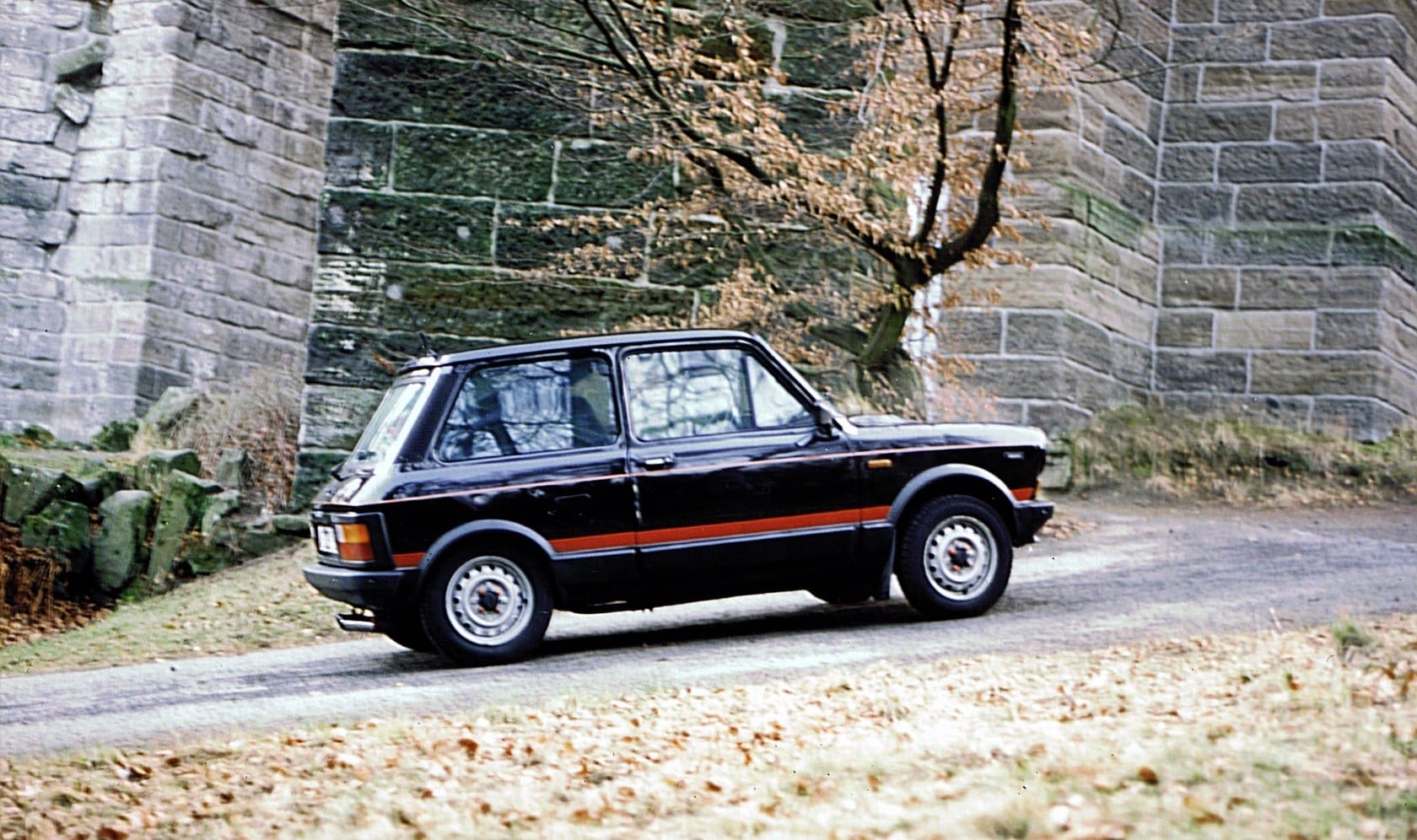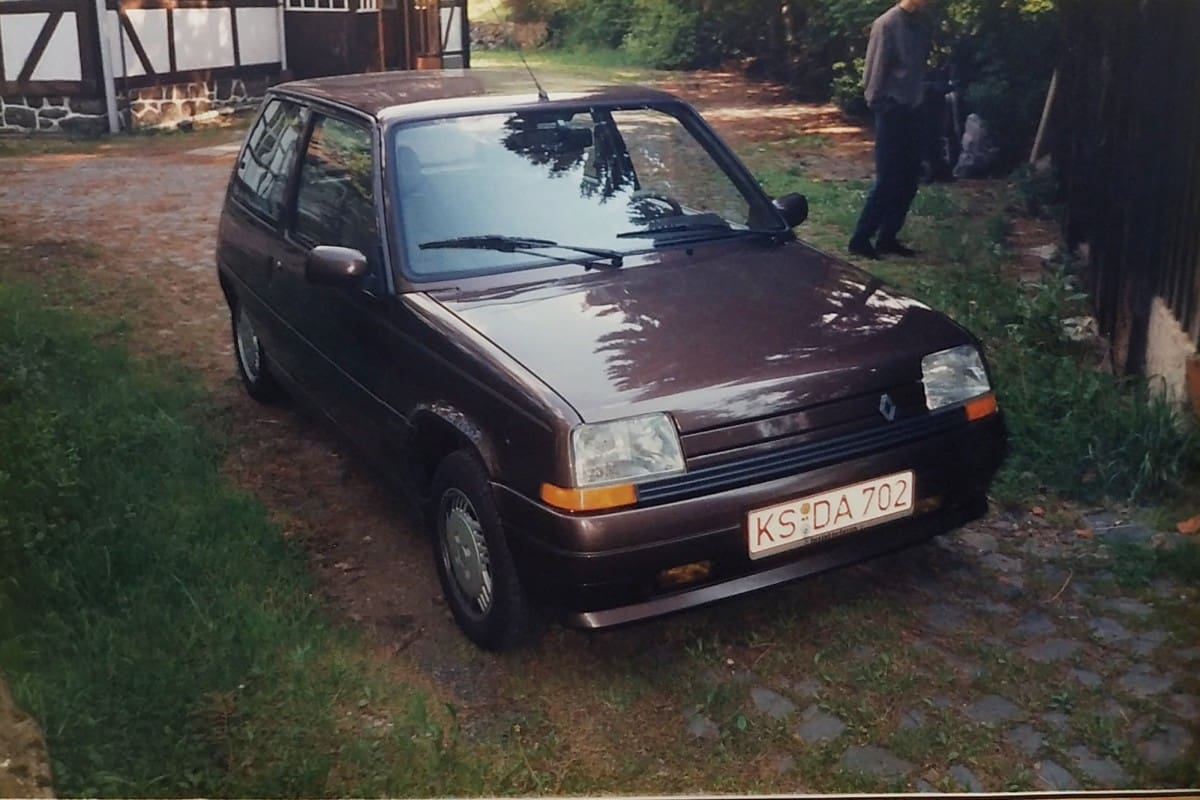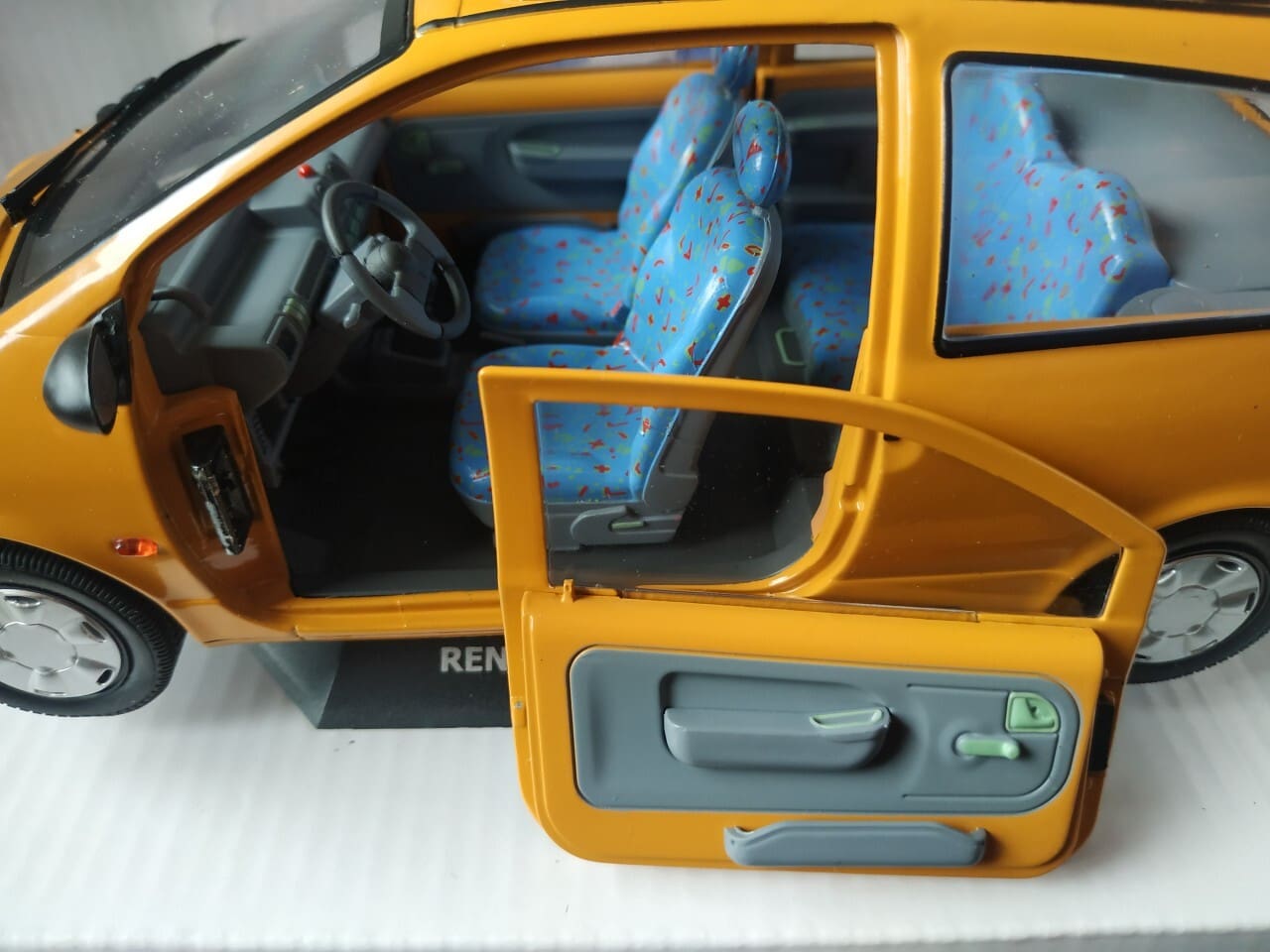Inhalt: [-]
- 1 Warning!
- 2 Everything used to be better?
- 3 Sorting?
- 4 Big Jim Camper
- 5 Volkswagen LT 28
- 6 Autobianchi A112 Abarth 70HP
- 7 BMW 1502
- 8 Citroën CX 2400 GTI
- 9 Renault 5 Baccara (Exclusiv)
- 10 Renault Twingo
- 11 Citroën Visa
- 12 BMW 320
- 13 Opel Kadett C Coupé
- 14 Peugeot 305
- 15 Alfa Romeo 2000 Berlina
- 16 Fiat Nuova 500
- 17 Tempo small lorry (A 400 / Hanseat)
- 18 „Family reunion“ 1972
- 19 Opel Kadett B Coupe
Here you will find automotive memories in the form of pictures of the cars of some friends and relatives – and my own.
Warning!
Yes, yes, kiddies, I know: today’s pumped-up cars weighing tonnes can do everything better, are faster and more fun. But back then we still drove our cars – and not the other way round. No power steering, no ABS, no ESP, no assistants such as automatic start-off systems with roll-back protection – and we still had to keep in lane ourselves.
If you were to drive one of these cars from now on – which you couldn’t, no joke, because you would be overwhelmed just by releasing a proper handbrake – you would end up in the ditch before the next bend.
You wouldn’t even be able to start off on a hill, because you never learnt that at driving school. What would be the point?
Is that an exaggeration? Hardly! Even a normal electric car today has over 350 hp and 700 nM. The performance of such a vehicle is equivalent to that of a Porsche. How is a housewife supposed to manage something like that without assistance systems?
Golf or Audi fanboys won’t get their money’s worth from reading this article either. Sorry, nobody in our circle of friends drives one of these. Okay, there is an A2, but that’s not an Audi in the modern sense.
„Yes, clever, give the readers a shit, Hessi. Well done!“ I just don’t feel like deleting comments written by car racing experts who couldn’t even check the air pressure or oil level without a computerised assistant.
Everything used to be better?
You didn’t have a child seat or seatbelt and you’re still alive! Lucky you! Many of your contemporaries weren’t so lucky.
The total number of road deaths in a whole year today is slightly higher than in just one month in the mid-1970s ! Less than a tenth! There are three times as many vehicles on our roads today! With more than twice the annual mileage! So there are six times as many vehicles on our roads today as there were back then! Or to put it the other way round: back then, 72 times as many people died on the roads in Germany as today, based on the number of kilometres driven!
The number of children killed in accidents in Germany was 1076 in 1971 and 103 in 2023, which is still too many. Since then, the number of cyclists killed in accidents has fallen by a quarter, although many more cyclists are travelling (much faster!).
Safer?
Safety mania? You didn’t have to wear a helmet on your old folding bike with your roller skates? You don’t really want to compare them with a modern children’s bike and modern inline skates, do you? They’re orders of magnitude faster than the old shit. And let’s not even get started on e-bikes.
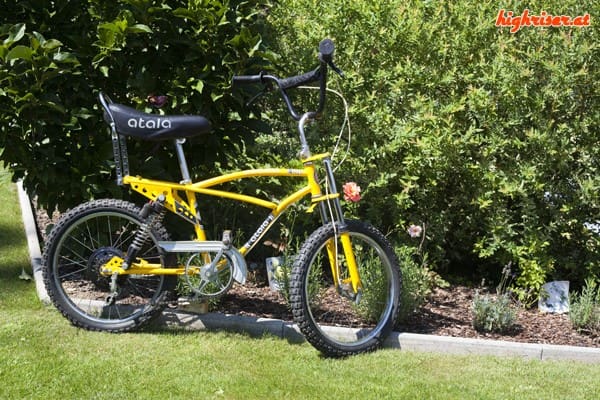
Not just any old folding bike, but a cult bike
The 1982 Autobianchi A112 Abarth 70 HP listed here is beaten in all respects by today’s small cars with a basic engine. The chassis was a complete disaster, with transverse leaf springs on the rear axle. Of course, for the 1960s, when the A112 appeared, the chassis was okay, but that didn’t mean that the car wouldn’t turn when the load changed in a fast bend.
in 2004, my ex-wife bought a Kia Picanto with 64 hp from a 1.1 litre engine. It had exactly the same driving performance as the Abarth with a very precise 50% (!) more weight, but an impeccable chassis that was more comfortable, safer and faster.
As the engine also had more torque and was quieter, a noisy and imprecise Abarth that relies on revs just feels faster. :-)
Not everything was better in the past, but everything was … in the past.
Nevertheless, old cars are of course much more fun with far less power. :-)
Sorting?
The order is unsorted.
First come my own vehicles, or those of which I was co-owner, then all the other vehicles in the order in which pictures come into my hands.
I’ll just start with my oldest picture: the one with the Big Jim camper.
Excuse me? That’s not a car?
Is that your article or mine?
Big Jim Camper
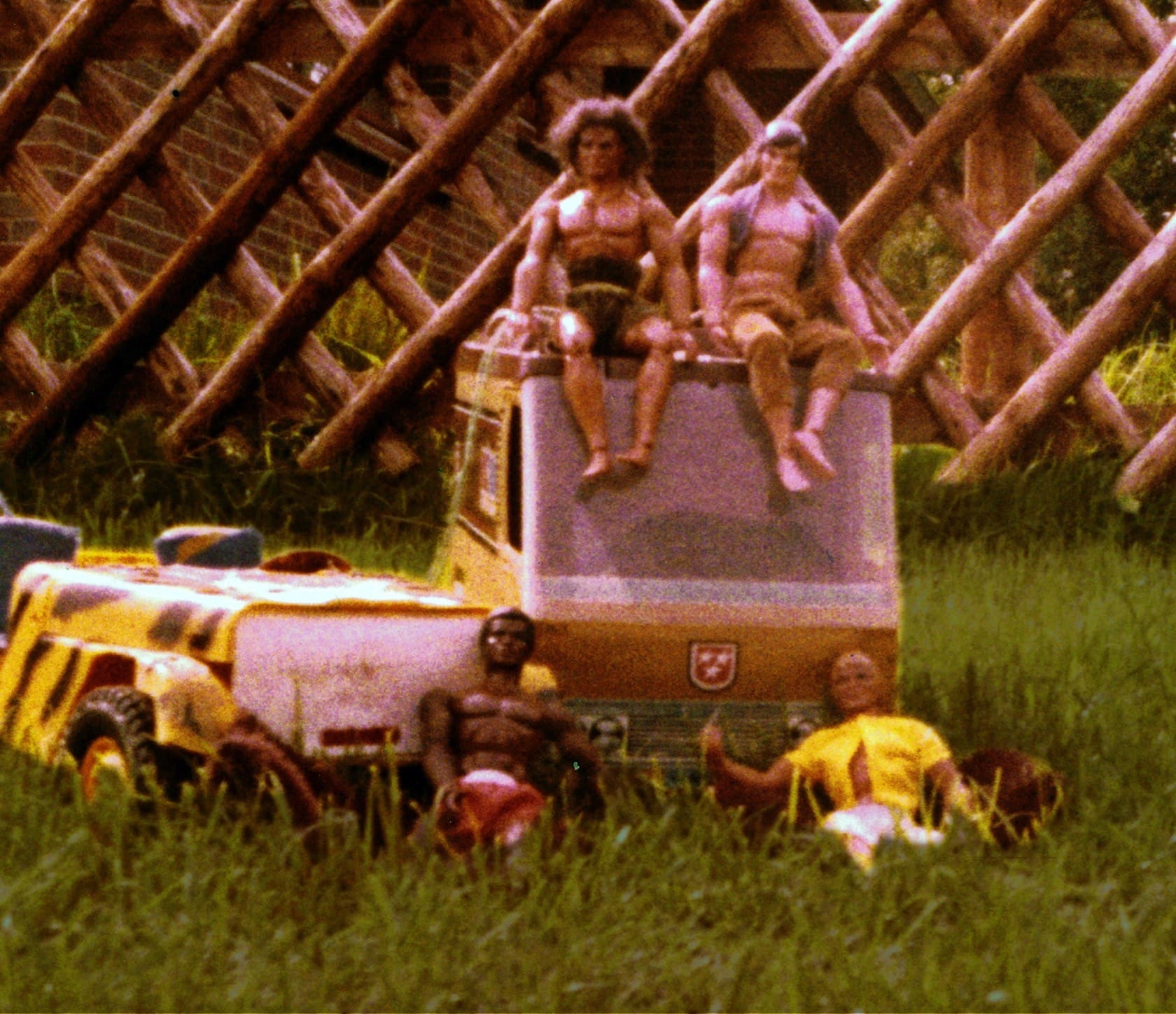
Technical data
| Big Jim Camper | |
| Length | 46 cm |
| Year of construction | 1974 |
My Big Jim Camper. As was to be expected, the photo from the Agfa Pocket had yellowed completely over the years. I was able to spice it up a bit with Photoshop, but the green had completely ruined it. I had to colour it in afterwards. You can see it on the edges. (Inside joke).
As a child, I fitted the yellow Jeep with an electric motor. It had a belt drive and was basically just too fast to play with. Today I wonder how I was able to attach the motor to the chassis at all.
I took this picture as a child in the early 1970s with an Agfa Pocket. We even recreated this scene later with a VW LT bus, which we took on holiday in 1987. Luckily for you, we were wearing T-shirts – unlike the Big Jim figures.
Driving performance
It’s embarrassing, of course, but even as a child I was someone who loved going on holiday in a bus like that – so I thought it would be kind of nice to tie a string to the camper, kit it out and then walk from my grandmother’s flat in Kassel across the meadows of Lutherplatz to Königsplatz and back.
It certainly looked strange: Walking with campers, or something. But I thought it was cool, because the camper was showing signs of wear and tear after a few trips. It was also exciting to see what fell out of its usual places during the journey and flew around in the car.
Volkswagen LT 28
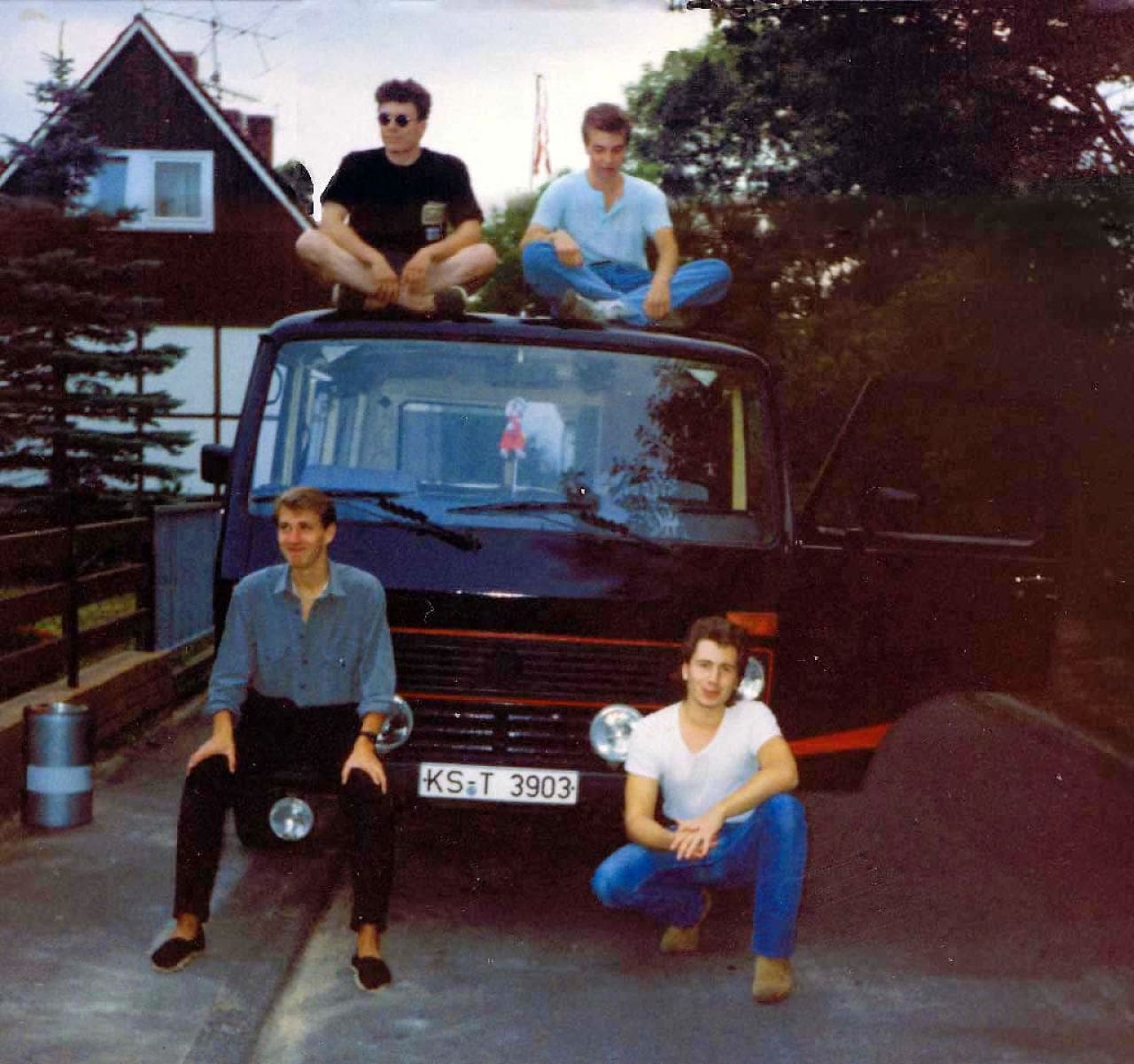
The VW LT picture is also worth remembering: Harry’s mum cut off our heads. In another picture, Matze was missing. Two become one – thanks to Photoshop. Unfortunately, all the discolouration in the images that occurs over time is of a gradual nature. I really didn’t want to use layer masks, it’s a pain in the arse to cover up the mistakes. But above all, adjusting the colour tones correctly is a real nightmare. So I don’t want to hear any complaints about the visible edges. :-)
Technical data
| Volkswagen LT 28 (1978?) | |
| Length | 485 cm |
| Width | 204 cm |
| Height | 216 cm |
| Turning circle | 11,9 |
| Wheelbase | 250 cm |
| Luggage compartment min | approx. 4,000 litres |
| Boot max | 7.850 litres |
| Unladen weight | 1.580 kg |
| Fuel consumption | Petrol |
| Engine capacity | 1.984 cm³ |
| Power (PS) | 71 HP |
| at rpm | 4.300 rpm |
| Max. Torque (Nm) | 132 Nm |
| at rpm | 2.400 rpm |
| Gearbox | manual, 4 gears |
| Drive | Rear |
| Top speed | 116 km/h |
| 0-100 (sec) | yes |
| Fuel consumption | 14.9 litres/100 km |
| Price | from DM 27,685 (1984) |
| Converted purchase price 2021 | from 41,325 euros |
| Year of construction from | 1975 – 1996 |
A vehicle as if cut from a shoebox. Angular, angular – inside and out.
When designing the VW LT, the design department at VW was on holiday. The only thing on the agenda here was the premise of maximum space utilisation and so the development task was apparently assigned to the deputy warehouse clerk.
It is well known that VW are masters of reutilisation. The Polo II is a facelift of the Polo I. The Scirocco II is a Golf 1, the Golf VI is a facelift of the Golf V and I’d better not even start on the buses. But they’ve overdone it with the LT: Almost 20 years in the programme and basically there was just a facelift with angular headlights? Respect.
We actually bought the LT last hand. It was the short and flat version with a 71 hp Audi two-litre petrol engine and came in the distinctive signal orange of the construction site vehicles (navy yellow).
Like all VWs of the 1970s, the LT rusted away faster than you could look. But this one didn’t need much welding. We generously covered the flash rust with paint from the DIY store.
Upgrade
On the outside, we painted it similar to the A-Team bus, but completely in black with a red stripe on the side.
The action in Schröder’s boss’s yard is unforgettable: under a large canopy, Schröder sprayed the paint onto the van with a compressor and a spray gun. It fits. Inside, we painted the bus beige and covered the canyon brown artificial leather upholstery partly in NATO olive and partly in khaki. It was a kind of safari military look.
Double chrome exhaust trims protruded from under the sill. The additional headlights were just as fake. But the red GTI radiator grille was a point of honour and provided the necessary overtaking prestige. It’s just a shame that an LT with 71 hp can only overtake bicycles, mopeds or walking frames.
We assembled the interior from an old fitted kitchen. Afterwards, we had everything on board that our hearts desired: bench seat, table, TV (never used), sound system and a built-in bed in the rear with a huge boot underneath.
The rear windows were tinted dark. There was also an extra-long CB radio aerial (DV 27-s) wobbling on the roof, whose standing wave adjustment thingy promptly broke off when we drove under a bridge in France. That was it for CB radio from then on.
Our evening stop in Cannes was also unforgettable. Harry opened the side door on the seafront promenade. For some reason, he must have overlooked the fact that a considerable number of empty beer cans had collected in the hole in the step. They naturally fell onto the tarmac with a loud clatter. A good, stylish attention-grabber.
At that time, sat navs only existed in sci-fi films. So of course we ended up in Monaco right in front of the casino. Harry nodded condescendingly to the astonished-looking staff – his hand with the beer can hanging boldly out of the passenger window.
The next day there was also the Monegasque cop (dude, what respectable uniforms they have!) who stopped us and asked for drugs. Somehow it was on the tip of my tongue whether he wanted to buy some. But in the interest of our planned onward journey, I just about managed to refrain from doing so.
The starter motor had a problem. It was stuck if you didn’t let it turn again with a crack before switching off the engine. Funny, Boris always forgot to do this procedure, so we had to push the bus regularly. Early morning exercise is thoroughly overrated!
Driving performance
What a car. The engine was mainly characterised by constant overtaxing. We could only manage a small pass on Lake Garda in first(!) gear! A considerable queue of annoyed locals and holidaymakers from various countries formed behind us. The only thing you can say is: traffic jams are only bad at the back, it’s nice at the front.
Believe it or not, we actually had a race with a Ferrari on the way from Monaco to San Remo in the evening!
In the city, we challenged him to a traffic light duel with the engine roaring and a quick start. The guy was already completely annoyed because we were really giving it our all while he was presumably jerking from traffic light to traffic light in first gear. Boris added synchronisation to the whole thing. He imagined that the passengers were called Rodriguez and Claudia and dubbed their dialogue.
For example: „Rodriguez! Do something! These rednecks want to overtake us! Step on the gas, you’ve got 400 hp!“. Rodriguez, with a depressive undertone: „Yes, but … they have a double pipe exhaust!“.
At one point the road was so badly potholed that we actually abandoned the Ferrari. He then had to drive a few kilometres behind us, which he obviously didn’t like. He suddenly took a sharp right turn and disappeared.
Some time later, however, he shot us from the right – in a powerslide, out of a side street – directly in front of the radiator. Claudia must have been very proud of her Rodriguez at that moment! But so were we!
The end
After the holiday, we sold the LT again for the price we had bought it for and were satisfied.
Autobianchi A112 Abarth 70HP
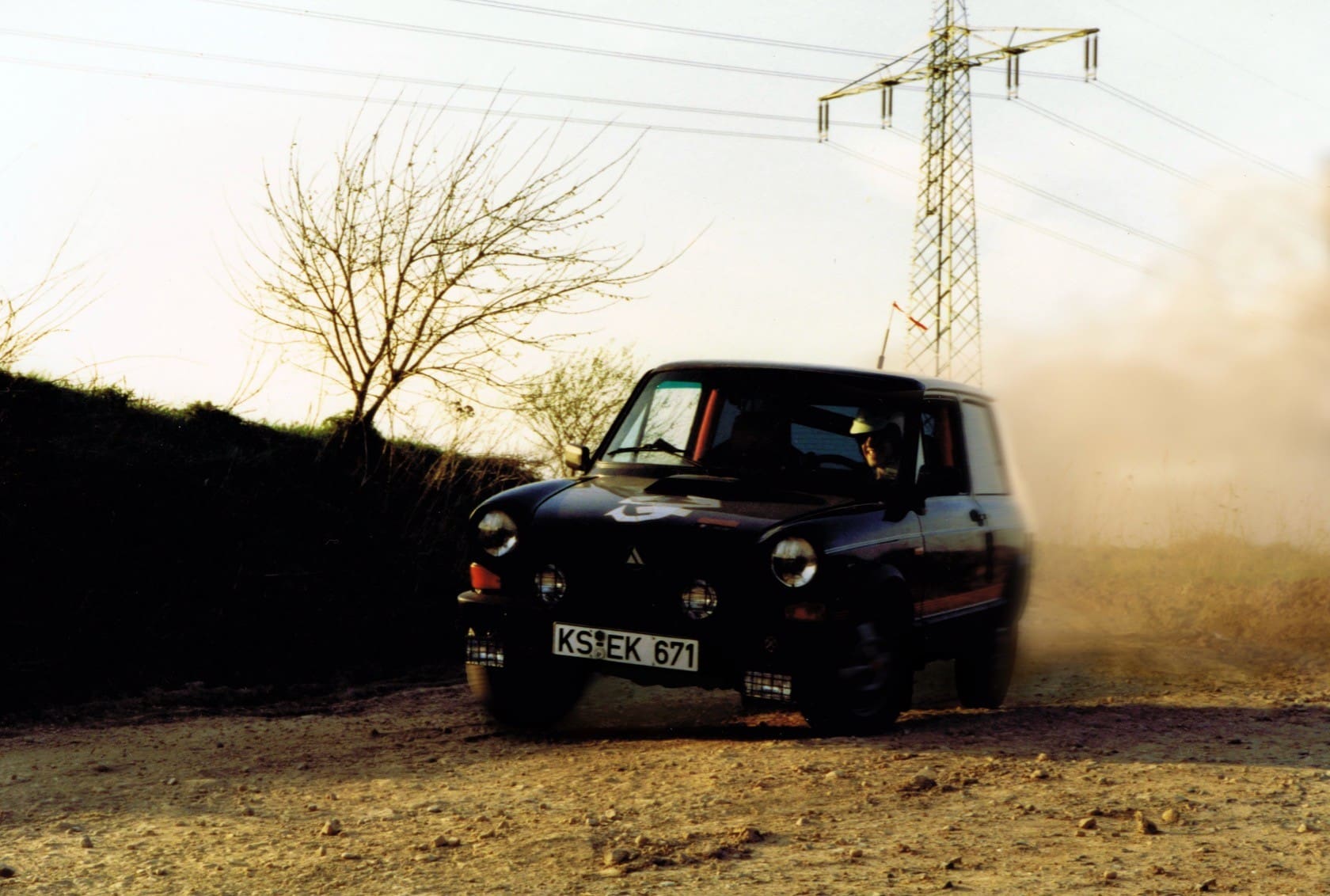
Technical data
| Autobianchi / Lancia A112 Abarth 70 HP (1983) | |
| Length | 323 cm |
| Width | 148 cm |
| Height | 137 cm |
| Turning circle | 9,4 m |
| Wheelbase | 238 cm |
| Boot min | 160 litres |
| Boot max | 395 litres |
| Unladen weight | 700 kg |
| Petrol | Premium petrol |
| Engine capacity | 1.036 cm³ |
| Power (PS) | 70 HP |
| at rpm | 6.600 rpm |
| Max. Torque (Nm) | 85.5 Nm |
| at rpm | 4.100 rpm |
| Gearbox | manual, 5 gears |
| Drive | Front |
| Top speed | 155 km/h |
| 0-100 (sec) | 13.2 sec |
| Fuel consumption | 8.4 litres/100 km |
| Price | from 9,980 DM (1977) |
| Converted purchase price 2021 | from 20,676 euros |
| Year of construction from | 1969 – 1986 (1979 -1984) |
My first car was a black Autobianchi A112 Abarth 70 HP (actually a Lancia). That car ruins your driving style for the rest of your life. :-/
Today, it’s hard to imagine how a car with „only“ 70 HP can go off. Furthermore, the quality was also beyond today’s imagination. I bought the car when it was five years old and had 70,000 kilometres on the clock for DM 4,700 (converted for 2021: €6,200). The condition was excellent: only two patches of rust (which you could see).
The sound, the toxicity and the subjectively perceived driving performance were terrific. My brother, who still has no driving licence, loved this car so much that he painstakingly cut out a gold-framed, silver Scropion for the bonnet from D-C-Fix. He once commented on the sound of the Abarth: „It just sounds sporty and not as pretentious as a GTI!“.
Yes, the sound was fine. Although a Golf I GTI doesn’t sound as bad as he thinks. When I look at today’s cars with the embarrassing, artificial misfiring that Idio… Fanboys as „technically necessary“, I could smash the driver’s face in with growing enthusiasm. In our day, we didn’t need shit like that.
Damage
Well, okay, I installed a second-hand Ansa system in the Bianchi, but it wasn’t worth it. Compared to the one from Abarth, it was made of aluminium foil and didn’t sound any better. However, I didn’t want to put the Ansa system under my car primarily because of the sound or an imaginary increase in performance, but because the Abarth system was damaged.
The underbody of the A112 could not rust, as it was always well preserved by oil that was squeezed out of all the engine seals. However, the oil also attacked the engine mounts, causing the engine to tilt further than intended. As a result, the exhaust pipe was slowly but surely pulled further and further out of the manifold until it eventually came loose.
On the way back from Sonthofen to Kassel, the time had come: I suddenly heard a scratching noise under the car on the motorway. I pulled over and had a look. Crap. The pipe grinds on the ground when the car compresses. Stupid. No tools and no desire to call the ADAC. They didn’t have mobile phones back then, did they?
So I drove on more slowly and the exhaust scratched the tarmac every few bumps. When I got home, half of the centre pipe was gone. Reason enough to install the above-mentioned exhaust system from Ansa. But… shouldn’t the cause, the engine mounts, be repaired first? Fiddlesticks, when you’re twenty you prioritise! Engine mounts are boring!
When the Kurfürsten Galerie was being built in Kassel at the time, there was also roadworks in the Wolfsschlucht gorge with a sharp edge in the tarmac where the centre tube got stuck. It almost sounded as if someone had crumpled up a piece of aluminium foil when the exhaust system folded up to half its original length. A stupid thing to do.
Stupid too: I drive away from the Schröder, stop at the first junction, take my foot off the brake and hear a ringing. I get out of the car and have a look. There’s something under the car… the backing plate of a brake pad! That was the beginning of me becoming a car hypochondriac and since then I can hear every little ache in my car before it becomes a real problem.
I changed the clutch on Bianchi with the Schröder in a hire garage. What a job! We didn’t want to remove the engine completely, just let it down a bit, loosened the gearbox and changed the clutch. That took more than half a day! Meanwhile, a guy with a Kadett D drove onto the neighbouring platform. Also changing the clutch. We talk briefly, he condoles us, lifts his car, opens a flap on the gearbox, old clutch out, new clutch in, flap closed, car down and he’s gone. What a puke we had.
I bought a cheap roll bar and a „rebuilt“ engine for the Abarth, which supposedly had 85 hp, from an acquaintance at a petrol station. After the conversion, which I could have saved myself, the dynamometer showed a pitiful 65 hp. Later, the engine also had bearing damage, which was no wonder, as it squeezed the oil out faster than I could fill it in.
Driving performance
At night at the petrol station, I heard someone giggling: „Haha, look at the hat on the car!“. His colleague only said in awe: „Pssst! That’s an Abarth!“!
Well, that was already an exaggeration at the time, because the A112 wasn’t really fast objectively. The 70 hp with a kerb weight of 700 kg wasn’t that bad, but at the end of the 1980s such a power-to-weight ratio was slowly becoming the norm.
Add to that the really poor Cd value and you were already being overtaken by 60 hp Cadets on the motorway. You only had a real chance of not being overtaken by a GTI up to second gear. From 80 at the latest, you were mercilessly blown away.
On the motorway, 155 km/h was the end of the road. The speedometer shook exactly on the „170“ mark, but we probably only believed that alone at the time. :-) With the advent of the Polo G40, we were victims on the motorway too.
Even the standard, rather comfortable suspension with rear transverse leaf springs was no longer up to date. In a fast bend, you only had to remember to ease off the accelerator to end up as a humming top. Even though a Polo II was based on the complete floor assembly of the Polo 1, the first VW Polo was already the superior design thanks to the twist beam rear axle. However, none of this detracted from the fun of driving the Planschi.
The end
The car ended up in the press after an unfinished restoration attempt.
The model
I own the Autobianchi as a 1:18 model.
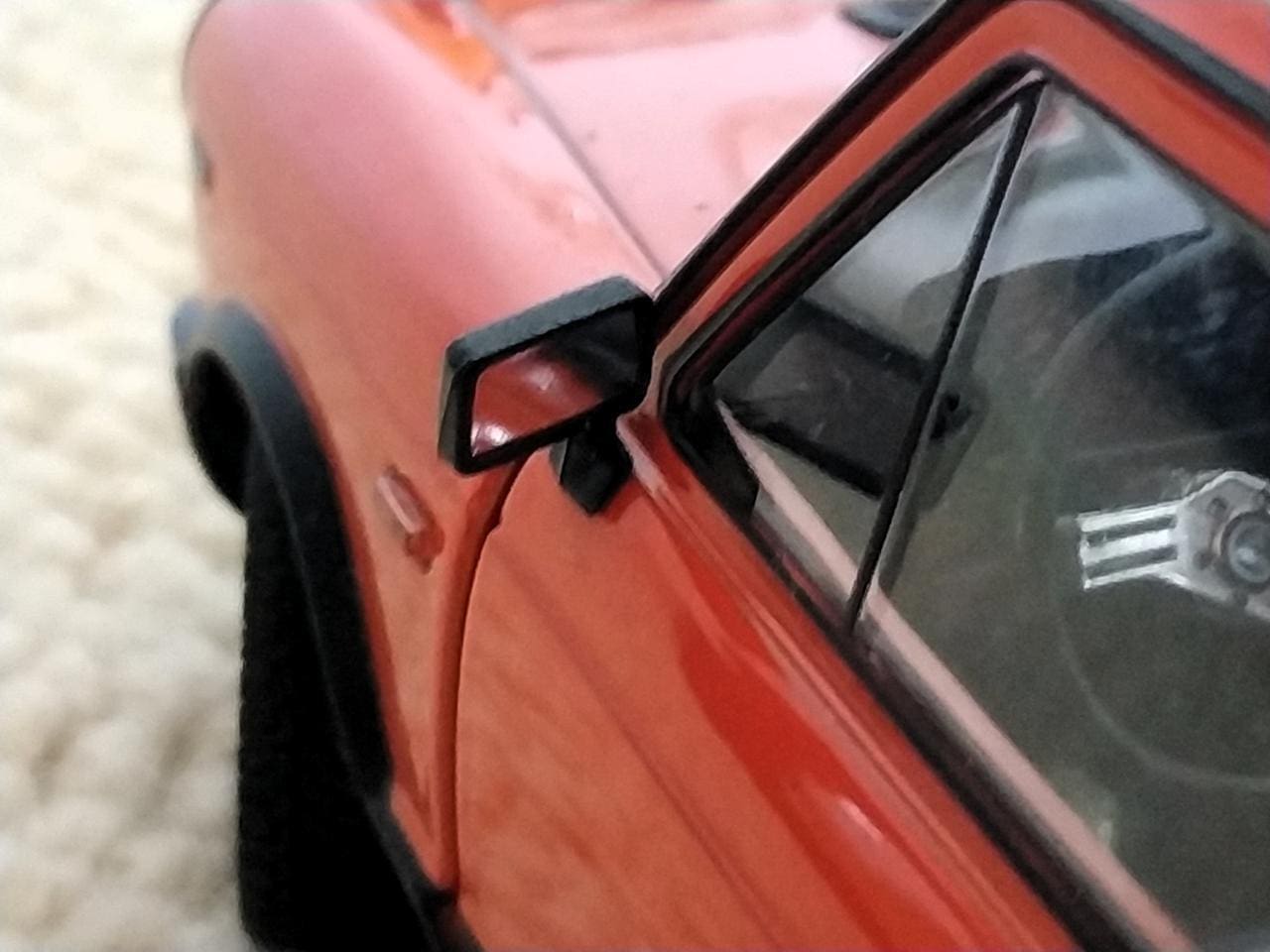
BMW 1502
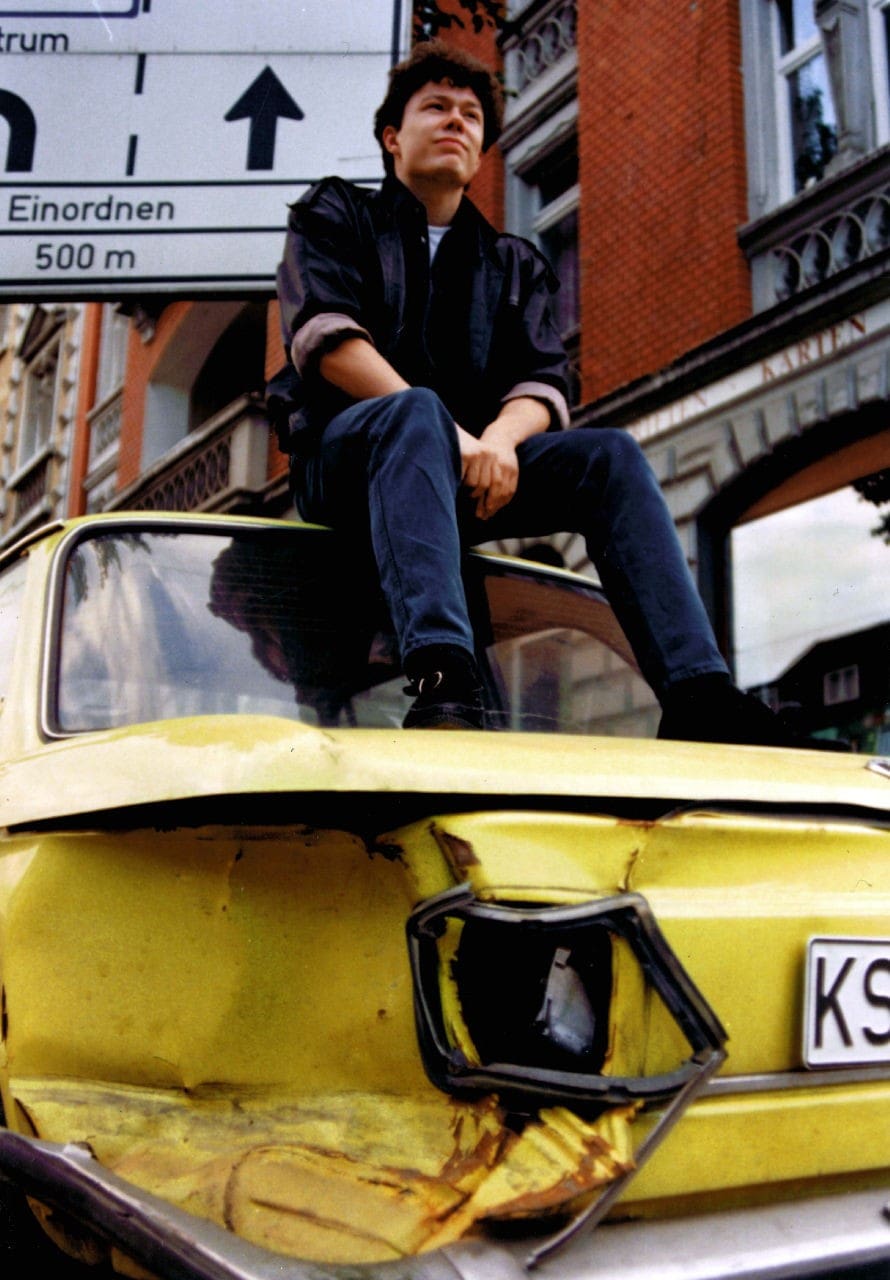
Technical data
| BMW 1502 (1975) | |
| Length | 422 cm |
| Width | 159 cm |
| Height | 141 cm |
| Turning circle | 10,4 m |
| Wheelbase | 250 cm |
| Boot min | 450 litres |
| Boot max | 450 litres |
| Unladen weight | 980 kg |
| Fuel consumption | Regular petrol |
| Engine capacity | 1.573 cm³ |
| Power (PS) | 75 HP |
| at rpm | 5.800 rpm |
| Max. Torque (Nm) | 117.5 Nm |
| at rpm | 3.700 rpm |
| Gearbox | manual, 4 gears |
| Drive | Rear |
| Top speed | 155 km/h |
| 0-100 (sec) | 13.8 sec |
| Fuel consumption | 10.2 litres/100 km |
| Price | from DM 11,390 (1975) |
| Converted purchase price 2021 | from 27,227 euros (1975) |
| Year of construction from | 1966 – 1977 (1975 -1977) |
My lemon yellow BMW1502, my second car, which I only bought for use during the restoration of the Abarth, cost me 1,000 DM (1,230 euros in 2021).
Cool! Rear-wheel drive! That’s something!
Nope, nothing worked. 75 hp was simply not enough to have fun, a 1,600cc engine is not a poisonous, Italian revving sow, but rather a tractor engine in comparison. Consequently, the rear end only got around on wet cobblestones. But I have to say that it was fantastically controllable, so that I soon knew every cobblestone track in Kassel.
I still remember the first few kilometres in this BMW very well. I knew that the 1502 had been introduced during the 1973 energy crisis and was supposed to be particularly economical. I tackled my first tour of the Kassel region with a full tank of petrol.
On the B7 from Kaufungen and Helsa: I was still totally happy when I left the town, because the fuel gauge had hardly moved for the last 100 kilometres. What a great car! I looked at the dashboard and marvelled at the old-fashioned but somehow sporty and solid interior. I also liked the smell.
It was afternoon and the dark clouds of an approaching summer storm were gathering. The empty, four-lane main road in front of me, the engine purred, I actually felt comfortable in this car, it had something. So I was very happy – until the moment I looked at the fuel gauge again!
Dude! What’s up? The needle is at 3/4? It was just full!
On the way back it dropped to 1/2 and at home it stopped at 1/4. What a cheat! The box easily drained 10 litres! Much more than my old paddler!
Fortunately, I only had to stare at this cheating petrol gauge for a few weeks, because the gearbox soon gave up – I admit that it blew up in my face when I drifted from cobblestones to tarmac. From then on, it sang the shrill song of its imminent demise. But I didn’t have to listen to that for long either…
The end
A short time later, the 1502 was shot down by an Audi coupé at a junction in the Fritz-Erler barracks on a Saturday after my UvD.
I wasn’t even doing the permitted 30 because I was at a junction! Just looked to the right… all clear. I pull over… I’m at the junction… I see something flying towards me in the corner of my eye and accelerate again.
It was no use, it caught me.
Of course he wasn’t doing 30. More like… 80 km/h? ;-)
I still had the spare gearbox in the boot, which I wanted to fit that day. Well, that was all taken care of.
As you can see from the picture, I’m just glad he didn’t catch me at the door, otherwise I’m sure I wouldn’t be writing this today. Funny:
The barracks commander, a lieutenant colonel, IIRC, had heard the loud bang and came round about a minute later. We all just looked at each other perplexed, I think we just said hello.
The commander looks at the wreckage. He turns round, thinks for a moment and then just says, „Right … left … well, that’s all right then. You’ll be all right?“. Both drivers nod. Insurance paid out. End of the story.
I sold the 1502 for the small mark (even smaller) to one of the 02 fans from Kassel. I deregistered it and the guy wanted to come round and pick it up that day. But it didn’t happen.
It took weeks. In the meantime, I looked out of the window and saw that the car already had a signal red sticker on the windscreen. „Get rid of the scrap, otherwise we’ll do it. Best regards, your city of Kassel.“
Then one day it was gone. I’m not sure whether the city or the buyer took it away, but as I never heard anything more from the city, it must have worked.
Citroën CX 2400 GTI
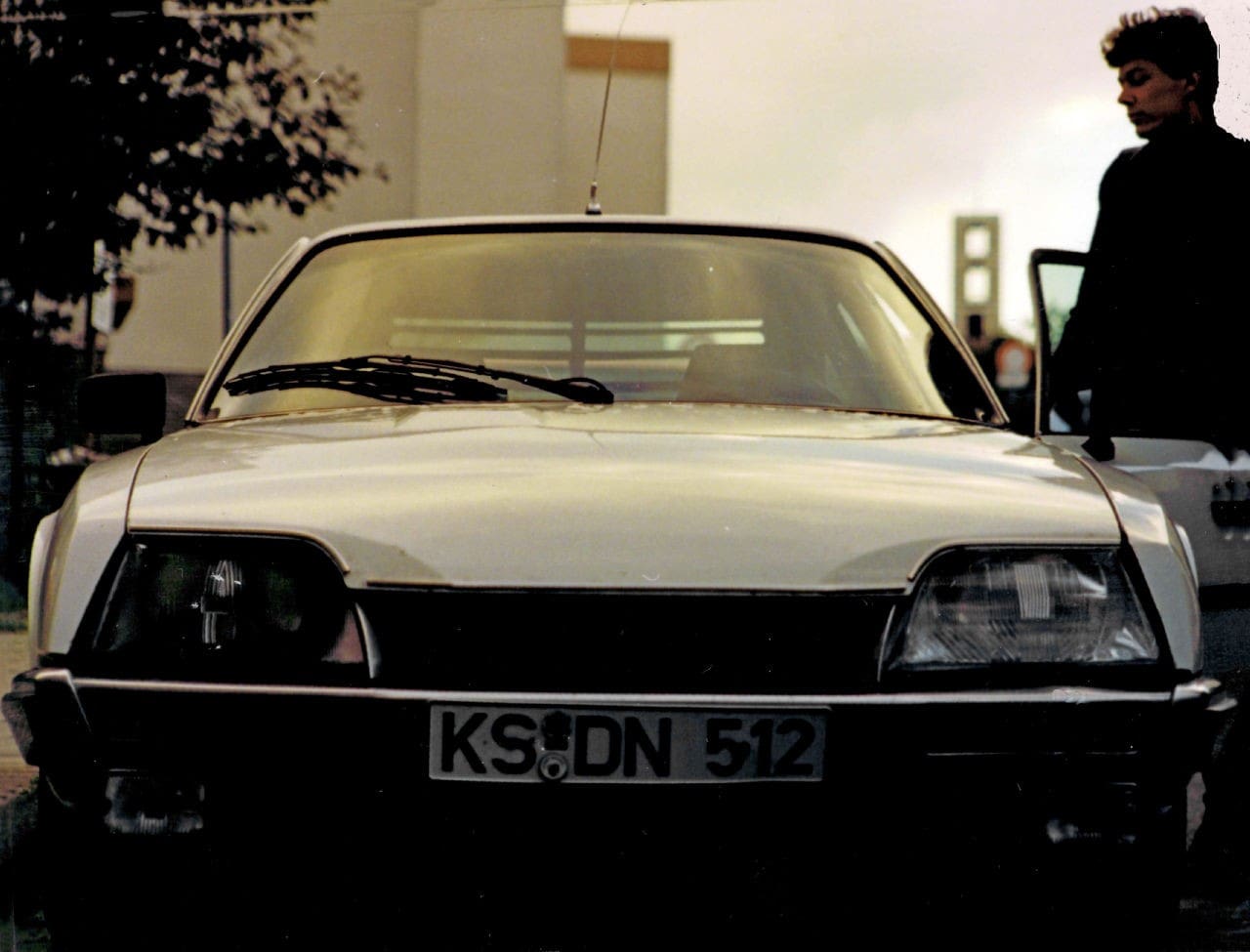
Technical data
| Citroën CX 2400 GTI (1982) | |
| Length | 466 cm |
| Width | 176 cm |
| Height | 136 cm |
| Turning circle | 12,1 |
| Wheelbase | 285 cm |
| Boot min | 410 litres |
| Boot max | 410 litres |
| Unladen weight | 1.330 kg |
| Petrol | Premium petrol |
| Engine capacity | 2.331 cm³ |
| Power (PS) | 130 HP |
| at rpm | 4.875 rpm |
| Max. Torque (Nm) | 198 Nm |
| at rpm | 3.750 rpm |
| Gearbox | manual, 5 gears |
| Drive | Front |
| Top speed | 192 km/h |
| 0-100 (sec) | 10,5 |
| Fuel consumption | 12.5 litres/100 km |
| Price | from DM 25,890 (1979) |
| Converted purchase price 2021 | from 47,180 euros |
| Year of construction from | 1974 – 1991 (1974 – 1985) |
The white Citroen CX 2400 GTI, my third car, can be summarised as follows:
„For his is the power and the glory forever!“
Blue inside, with a yellow magnifying speedometer and a rear exterior blind, the interior was almost pornographic. A blue interior was a real statement.
I bought it in 1990 on the advice of my mate Tom from my mate Schröder’s brother-in-law:
„I know my way around it, I’ve had three of them. My father also has a lot of spare parts and has only ridden CXs for years! If there’s anything wrong with it, we’ll get it sorted,“ Tom tried to sell me the bike. I took the bait and gave Jens, the car dealer by marriage, DM 2,200 for this beautiful 1982 Citroën CX. In 2021, that would be around 2,250 euros.
Driving performance
The CX used to be a company car and apparently only knew full throttle. It ran accordingly well!
The revs could drop below idling speed in fifth gear in the city, one step on the accelerator pedal and the thing simply pulled away without a hum.
On the motorway, it ran up to the speedometer stop at 210 and then continued to rev happily for another 500(!) revs up to the rated speed.
I’ll never forget the face of the poor passenger of the Opel Manta GTE owner, who thought he had to overtake us on a hill on the motorway.
There were five of us in the CX, Harry sat in the back in the middle because he had really, really bad bursitis in his knee and could only sit with his leg stretched out, which he had to tell us again and again at every non-existent opportunity. Anyway… the Manta GSI wants to overtake us on the mountain. *giggle*
A quick question: „There’s a Manta trying to overtake us! It’s your petrol! What should I do?“ – all like this: „Gaaaaaaas!“.
Hessi accelerated and we waved cheerfully after him as he dropped back.
The discussion with a 5-cylinder Audi coupé driver in the „Mayer-Lanski“ was also funny: he had eight hp more than my CX. His Audi is smaller and lighter (100 kg). He would blow me away. I nodded and smiled. Rightly so, as we all know today, because when an Audi coupé like this has over 110 hp on the test bench, the owner can be satisfied. But even double-digit performance is still „normal“.
Damage
After a while, Tom no longer thought the car was sooo cool, because I took him at his word.
The exhaust pipe was worn out and the drive shaft simply fell off on the motorway. Tom got a new old exhaust from his father from the warehouse. It was from a CX diesel. But that doesn’t matter, because it’s the same exhaust.
One Saturday afternoon we were working in front of Tom’s garage in sunny weather. Something rattled in the silencer. I knocked it on the ground a few times and something saw the light of day… a thick, round piece of metal. There was a piece of a damn exhaust valve in the muffler. I still don’t want to know exactly how it made its way through the centre pot and what must have happened to the poor engine.
Tom fitted the drive shaft. In a motorway car park. Yes, that was extremely stupid. I had to go to work later, was running out of time and called Tom from the motorway service area. He came with one of his cars, gave it to me so that I could drive to the Bund, got a suitable drive shaft from Pappa’s warehouse and changed it in the car park. I guess that’s what you call an all-round service. :-)
The joke was: the „defective“ drive shaft was intact. It was just a little too short, as it also came from a diesel, which had a slightly narrower front wheel track than the GTI. So it had simply slipped out of the gearbox, the differential seized, no propulsion, and I rolled on to the motorway service area near Kassel.
Hoffo from Siegen, who was my shop steward in the army, had also taken a fancy to the car. He was a complete petrolhead anyway and we experienced the craziest things with all kinds of cars.
When I had the new CX, we discussed its performance. In Hoffo’s file was an extract from the central traffic register that read like a novel: He had once had a chase with the police on a country road in his father’s M5 without realising it.
He was sure that the CX could easily do 200 km/h on a country road. No, not at all, I said.
One thing led to another and during the lunch break he was suddenly at the wheel and we flew over a hilltop on a country road near Fuldatal/Rothwesten at over 200 kilometres an hour. He was happy and I was sweating profusely.
In the winter of that year, we had another discussion. I say: The car has a handbrake that acts on the front wheels and an axle load distribution that feels like 70 to 30, so the rear _cannot_ get around at all. He’s sure again: It’s possible! So in the evening we met up in the frozen car park below Wilhelmshöhe Castle. Tom and Schröder were also there again – and of course the craziest and coolest car nut of them all: Illenseer.
Everyone drifted around like fools. Except Hoffo and me. Hoffo jerked the wheel, stepped on the gas, provoked load changes, but nothing helped. The CX always drove stubbornly straight ahead. But after half an hour of hard work, Hoffo was successful again and the CX exceeded his expectations.
Unfortunately, we were just screeching passengers, while the heavy front end of the CX was endlessly circled by the light rear end. Hoffo was unable to catch the CX, but the car park was big enough and after a few turns we came to a safe stop.
After that stunt, Hoffo didn’t fancy drifting with a CX any more either. A few weeks later, I slid down the slope to a side car park at Herkules on the right. The Michelin TRX high-performance tyres were already completely worn out and I really struggled to get back on the road. With a lot of effort, I managed in the end, but it was clear to me that an accident was inevitable with these worn tyres.
The end
This tyre wear was the CX GTI’s undoing, as TRX tyres cost more than the car was worth at the time. Over 1,200 DM! That’s approx. 1,478 euros in 2021! For tyres!
I traded in the French car when I bought my R5 Exclusiv. I cleaned it again beforehand. What was that brown film of dirt on the inside/bottom of the door? Give it a rub. *crunch*. „Er? Good, it’s perfectly clean. No need to clean it. Fits like this!“
Underneath the paint was all rust and no more sheet metal. :-(
After exchanging the papers, the salesman from Renault Behrens just said: „Shit! Now I’ve got a CX in the yard!“ Well, how right he was ..
The model
I own the Citroën CX 2400 GTi as a 1:18 scale model.
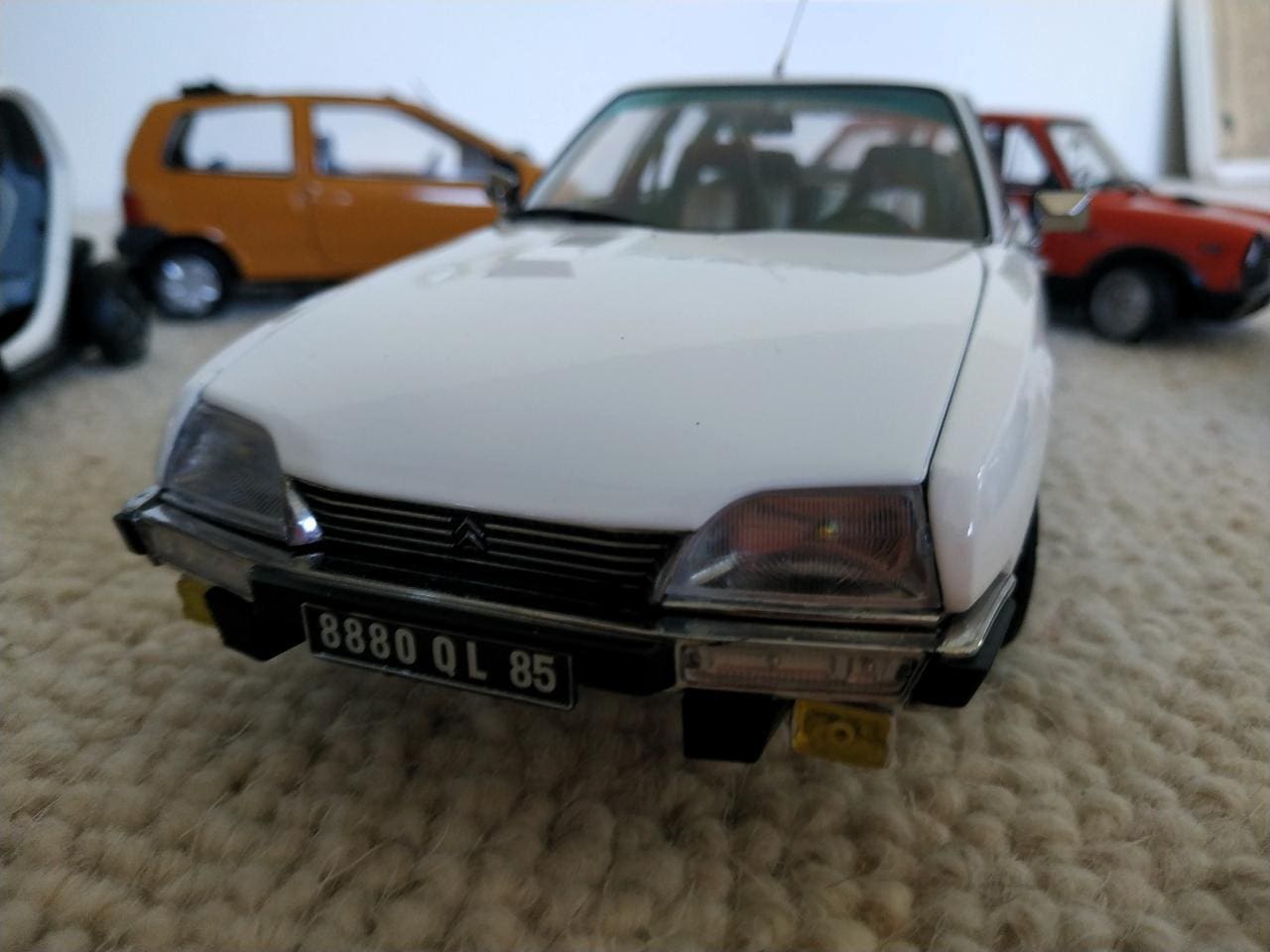
Renault 5 Baccara (Exclusiv)
Technical data
| Renault 5 Exclusiv (Baccara) (1987) | |
| Length | 359 cm |
| Width | 152 cm |
| Height | 140 cm |
| Turning circle | 9,8 m |
| Wheelbase | 241 cm |
| Boot min | 233 litres |
| Boot max | 917 litres |
| Unladen weight | 935 kg |
| Fuel consumption | Super petrol (unleaded) |
| Engine capacity | 1.709 cm³, register carburettor, U-cat |
| Power (hp) | 87 HP |
| at rpm | 5.500 rpm |
| Max. Torque (Nm) | 132 Nm |
| at rpm | 3.500 rpm |
| Gearbox | manual, 5 gears |
| Drive | Front |
| Top speed | 180 km/h |
| 0-100 (sec) | 9.8 sec |
| Fuel consumption | 7.7 litres/100 km |
| Price | from 21,900 DM (1987) |
| Converted purchase price 2021 | from 28,730 euros (1987) |
| Year of construction from | 1984 – 1991 (1987 – 1989, total number of units: 4,000 vehicles) |
Such an awesome car! Leather interior, thumb-thick velour carpet, leather compartment under the fluffy parcel shelf, electric windows, heated seats (retrofitted with original Renault switches), aluminium rims, discreet appearance, but good acceleration. „1.8″-litre engine (1,709 cm³), 87 hp, 180 top speed. Steering wheel, gear knob and brake system of the R5 GT Turbo.
I bought the R5 in spring 1990, for 14,500 DM, when it was a little over two years old. It was probably a leasing vehicle. Yes, it was expensive, but the market had been swept clean by the opening of the border. Only this little friend was still in the showroom. The buyers from the GDR spurned it. The salesman said that they couldn’t do anything with the equipment in a small car. Their bad luck, my good luck.
My first memory is of rolling down Ihringshäuser Strasse in bright sunshine and savouring the incredible smell of Conolly leather, which I remembered from a Jaguar XJ I rode in as a child.
Driving performance
An acquaintance in the army had a red R5 Turbo and we used to drive home after work on the Fuldadrom (Rotwesten via Graue Katze towards Kassel). It was all clear, he was in front of me, giving full throttle. I followed behind, he zipped right past me.
The next day he just said whether I had tuned the bike (NO! But I heard that question a lot). I just said: You just drove away from me. He saw it differently: „Normally, cars don’t stay in my rear-view mirror as long as your R5!“
I once had a completely absurd race with an R5 GTE driver at night on the A7 motorway through the Kassel mountains. Sometimes he was in front, sometimes I was.
At the exit from the A7 near Kassel onto the south bypass, I was in front. I wouldn’t have dreamed of taking my foot off the accelerator, because he really drove right up to my bumper on the descent.
So we both drifted from the slip road directly into the left-hand lane of the south slip road, which fortunately only started there. He drove after me all the way home. He put the windscreen down and shouted: „Man! That was awesome! Finally someone who can really step on the gas!“ – He also asked for a tuning, what else?
Another scene: The three of us in the R5, leaving the town, I accelerate, which is quite normal when leaving the town. But the Golf GTI behind me swerves out and drives into the oncoming lane. I don’t know what he was doing there, but a little later he pulled to the right again. :-) You have to have the right car to overtake. :-D
Same game on the motorway. I once had a 2 Series GTI behind me that first sucked up the slipstream and then tried to overtake me on left-hand bends on the motorway. Sometimes he even got up to my height and then dropped back again and again on the straight. That had real entertainment value.
I didn’t think the Citroën AX that followed me for kilometres in my slipstream was up to scratch. You can bet that it only had 60 hp, it was as rickety as it looked – outrageous! But the AX also went like hell. An AX Sport or an AX GTI would really be a dream of mine today. Back then, we test drove many of these potent small cars. These are some of the ones I remember:
- Citroen AX Sport (hell!)
- Daihatsu Charade 4WD (lame), because the dealer wouldn’t give me the GTti!
- Corsa A GSI (went very well, but cramped interior)
- Seat Ibiza 1,7i (totally lame)
- Suzuki Swift GTI (angry, but really bad chassis)
- Honda Civic 1.6i (very fast!)
- Renault Clio 16V (nice!)
- Fiat Uno Turbo i.e. (scary rocket!)
From Saarbrücken to Kassel, I drove the Renault 5 at an average speed of 158 km/h. Including the initial rush hour traffic and a refuelling stop. So I’m not sure whether my R5 really only had 87 hp and could only manage 180 km/h. There was no GPS back then.
The car was still quite stressful on the motorway at first, because people would just pull right in front of my radiator. Discreet, dark-coloured small cars couldn’t also be fast. Since then, I’ve always driven with my lights on during the day. In other words, the R5 with its twin carburettors on the 1.7 litre engine was not directly underpowered. But those were completely different times. Today, every small car has a turbocharged 100 hp.
Equipment
However, the R5 Exclusiv was not a speeding car, even if it may look like one now. It was more of a dignified city car for the yuppie lady, which could also be used as a touring car for two people thanks to the engine and the not-so-rigid chassis, as you can see from the brochure layout.
The R5 Baccara (in Germany: „Exklusiv“) was only available in 1987/88 and only 4,000 of them were offered in Germany in the metallic colours Algerian brown (like mine), champagne and black. When my cousin Andreas saw the car for the first time, he simply commented: „Aha, a racer colour!“. Yes, metallic brown was indeed the colour of choice for BMWs at the time.
Oh yes: A BMW 7 Series driver once approached me when I opened the doors with the remote control. He looked at the car. He couldn’t believe that a small car could have similar equipment to his luxury-class vehicle. But nowadays there’s nothing special about remote control, heated seats and electric windows in a small car – apart from the leather interior.
No modern car comes close to the R5. They are no longer that tastefully furnished. Germans like their coal cellars. With a black interior, the car is easier to sell again, they believe, and configure the car not for themselves, but for the third hand. Really clever.
Damage
- Carburettor warped
- Broken regulator
- half broken
Carburettor
No cross-flow cylinder head, so the twin carburettor was roasted between the engine block and the bulkhead and warped. Clearly a series defect. The French solution was for Renault to offer a multi-component carburettor base gasket to compensate for the distortion of the carburettor even without tarpaulins.
I didn’t trust this or the workshop and pulled the carburettor off myself on a glass plate. After that it was actually quiet.
In hot weather, the float needle valve stuck once, which could be persuaded to start working again by hitting it with a hammer.
Alternator
The Renault workshop managed to tighten the belt that drove the alternator so strangely that it didn’t squeak, but vibrated so much that – no joke! – the regulator of the alternator was vibrated out of order. A new alternator cost almost 400 DM at the time. I went to the Bosch service centre and they dug out an old regulator from their box of leftovers. A fiver in the coffee pot and that was that.
Apart from that, the R5, which was regularly serviced, was amazingly reliable.
Accident
Shortly after buying the car, I decided not to take out fully comprehensive insurance to keep costs down, and the accelerator pedal got stuck under the rubber floor mat that the insurance agent had given me at the dealership.
I depress the clutch and the revs go through the roof, as I had previously given full throttle. I think the engine is going to run away, I stupidly let the clutch out again and the car goes forwards. Straight over a traffic island!
Result: bent centre stand, oil sump ripped open, frame warped! A flat tyre.
I was changing my bike in a car park directly behind the traffic island when suddenly two policemen stood in front of me. I explained the situation and pointed to the doormat I had thrown out in anger. The usual question about the papers. I put my wallet open on the bonnet with pointed fingers because my hands were completely filthy. My Bundeswehr service card (non-commissioned officer) is openly visible. They only see my ID and wish me a nice day. Presumably still within the bounds of discretion.
Far more illegal was the repair work that was done to my mum’s company car (also a Renault 5). Her boss took pity on me, and good customers of a car dealership are sometimes helped with insurance fraud. Okay, the statute of limitations has long since expired and the good man has unfortunately already passed away, but it wasn’t okay.
It was so unpleasant for me that I insisted on at least paying for the oil pan and installing it myself. Ever since then, I’ve known that if I can’t afford a new car out of my petty cash, I need fully comprehensive insurance. I’ve paid it faithfully ever since and haven’t had a single claim – how could it be any different?
The end
I parted with this fantastic vehicle after a drunken Bosnian man dressed in black ran right in front of my radiator in the drizzle at night.
He crossed Frankfurter Straße in Kassel about 20 metres before the tram stop at the Park Schönfeld children’s hospital. At the last moment, I saw his white(!) socks flashing through the drizzle in the headlights and went into full gear, but it was already too late.
There was a bang. A shower of shards sprayed towards us, I pushed myself backwards on the steering wheel, which my wrists still resent to this day.
The illuminated pedestrian crossing where the drunk was lying was still easily five metres away. Shortly behind me came the tram, which would surely have hit him otherwise, which would not have ended so lightly for him.
He actually only suffered bruising and a small splinter on his pelvic bone. The paramedics said that the man was so drunk that he no longer had any defence reflexes, so he didn’t hurt himself badly.
I remember that my girlfriend at the time and a passer-by took care of everything else before I opened my eyes again and wondered why I was in an ambulance. I must have forgotten to breathe, which can happen when you’re in shock.
A very friendly policeman carried out another breathalyser test, but I don’t drink when I have to drive. According to witnesses, the man simply ran off into the street, so the whole thing had no legal repercussions.
I was left with my damages, because the Bosnian was not covered by liability insurance.
I later heard that people in his circle of acquaintances were very happy about his accident because he already had several previous convictions for assault on his record. Despite everything, I still blamed myself, because a pedestrian is the weaker road user.
The bonnet, windscreen and roof frame of the R5 were broken. Yes, of course, the expert report listed a whole host of other damage, of course. The vehicle was an economic total loss. Thomas (who helped a lot with the whole thing with his girlfriend) looked at the wreck and said dryly: „If you’d been driving an S-Class, it would only have been on the bonnet.“
The Renault dealer offered me a ridiculous price for the car. I looked for a car buyer in the classified adverts in the newspaper who would pay me a reasonable amount. He was really annoyed when the Renault dealer, who was naturally keen on the car, kept him waiting for ages before finally handing it over.
My R5 should go to Poland, they were real artists in bodywork and sheet metal work and could rebuild the car at a reasonable price.
No way! Six months later, I saw my R5 parked in town. I looked at it in amazement! The bonnet had been replaced by a white one, the roof had obviously just been dented and the beautiful leather steering wheel had been replaced by a plastic one. Cruel!
While I’m still in a daze, a girl comes and opens the door. I just stammer: „That was my car. It’s supposed to be in Poland!“
After a brief conversation, she just said: „Did the deer suffer a lot?“
I replied insensitively: „It wasn’t a deer, it was a person!“
I was horrified and angry that they had botched up the car and sold it to an ignorant girl. I don’t think it passed the next MOT.
It wasn’t until many weeks later that I was mentally ready to get behind the wheel again. My circle of friends and not least my mum vehemently urged me to do so.
I now own an R5 Baccara again, albeit only as a model.
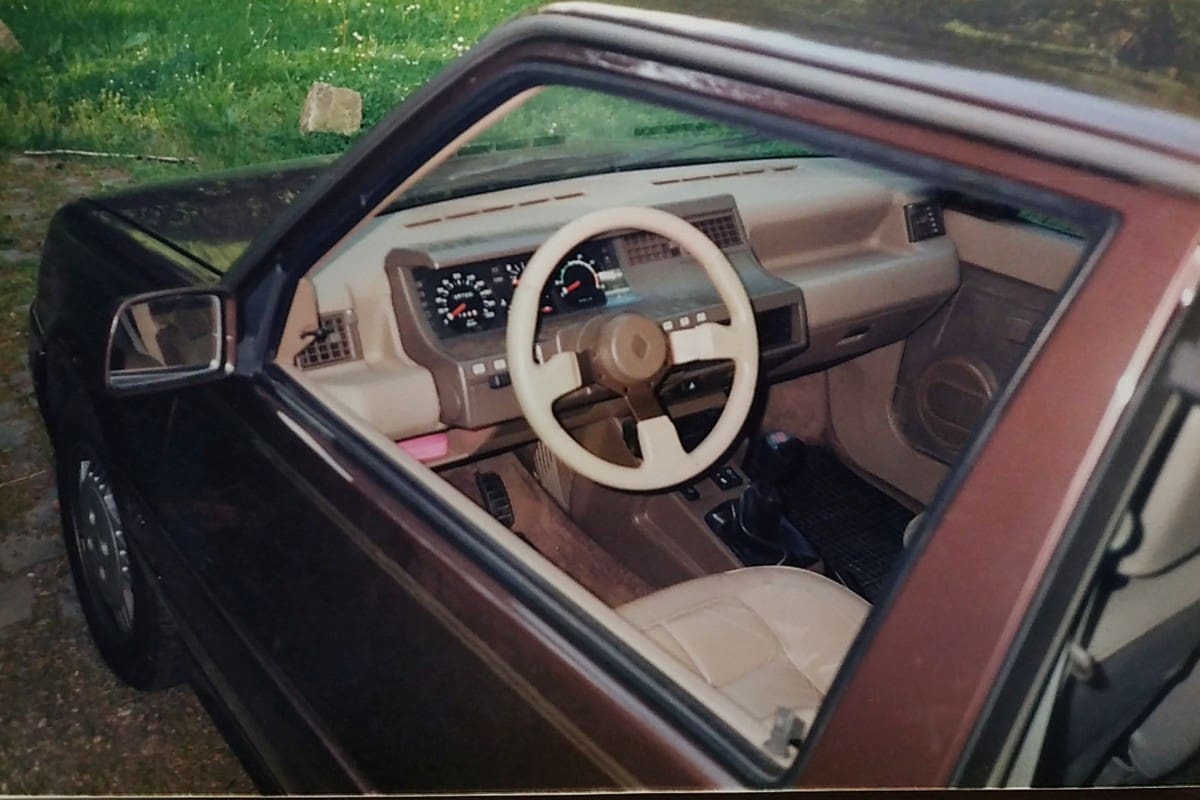
The model
I also own the R5 Baccara as a 1:18 model.
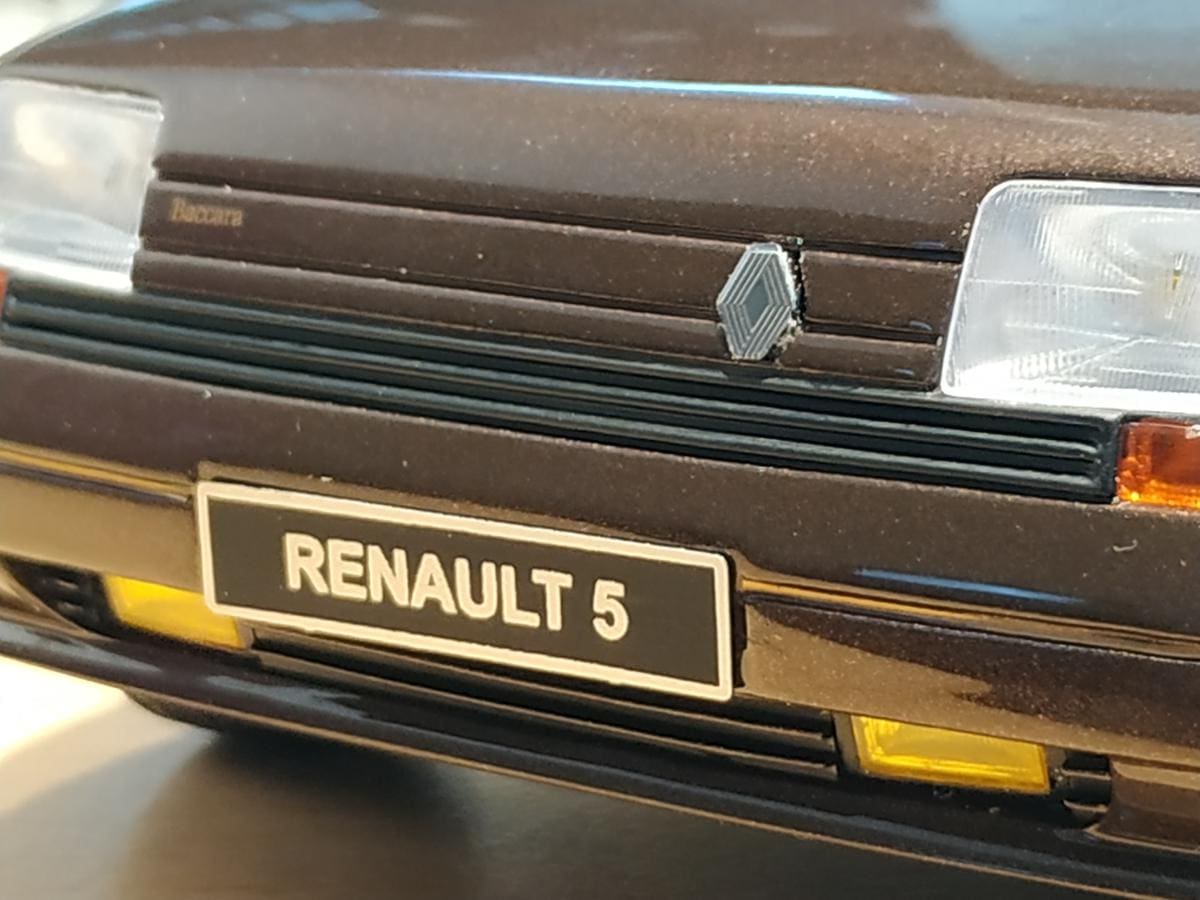
Renault Twingo
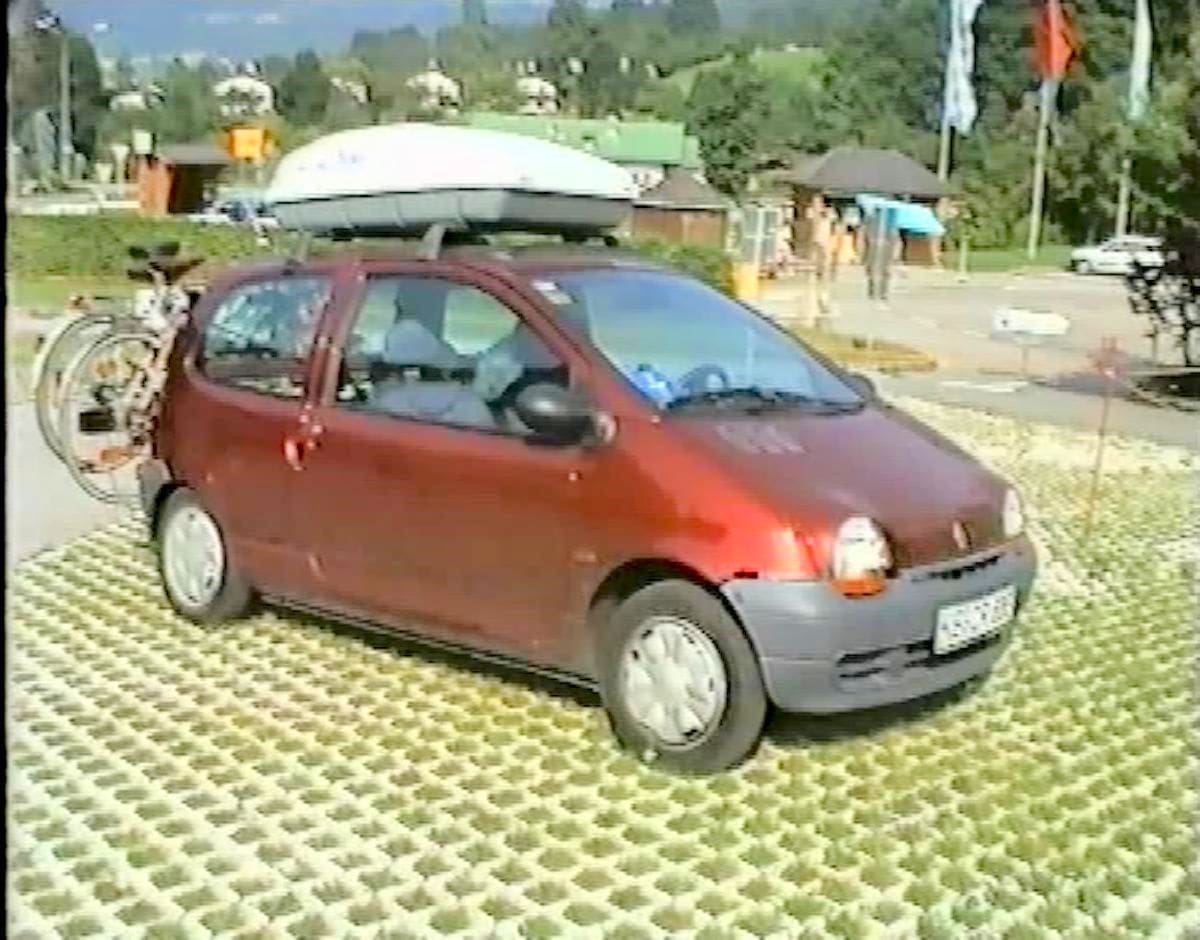
Technical data
| Renault Twingo (1994) | |
| Length | 344 cm |
| Width | 153 cm |
| Height | 142 cm |
| Turning circle | 10.0 |
| Wheelbase | 235 cm |
| Boot min | 168 litres |
| Boot max | 1.096 litres |
| Unladen weight | 825 kg |
| Fuel consumption | Premium petrol |
| Engine capacity | 1.239 cm³ |
| Power (PS) | 55 HP |
| at rpm | 5.300 rpm |
| Max. Torque (Nm) | 90 Nm |
| at rpm | 2.800 rpm |
| Gearbox | manual, 5 gears |
| Drive | Front |
| Top speed | 150 km/h |
| 0-100 (sec) | 14,0 |
| Fuel consumption | 6.5 litres/100 km |
| Price | from 16,000 DM (1993) |
| Converted purchase price 2021 | from 16,520 euros (1993) |
| Year of construction from | 1993 – 2007 (1993 – 1996) |
I was given a Twingo as a workshop replacement car during an inspection of the R5. It was parked in their yard and I was immediately blown away!
I used to dream of a Renault Espace, but I could never afford it because they were really expensive when new. Now there was a „naked“, yellow Twingo at the dealer – a baby Espace!
I was thrilled and was sure that in future all modern cars would be designed in a one-box design. Unfortunately, I was wrong, because to my horror, such embarrassing, bland abominations as the Audi A6 or VW Arteon came onto the market. All of them with coal-cellar equipment, because they were leased and configured for the last hand.
Anyway, so there I was driving this new Twingo, the antithesis of my R5. Sparsely equipped without anything: bare sheet metal inside, no electric windows, no central locking, not even an interval for the rear window wiper was granted to the Twingo!
And the performance? Hardly any! The engine, a poorly developed grey cast iron block from the 1950s, which had already done its rough work in the R4, pushed just 55 hp onto the crankshaft.
Nevertheless, I couldn’t get the grin off my face. The car was simply fun to drive and offered great all-round visibility and an incredible feeling of space. I had to have it!
Well, I got my wish sooner than I would have liked. The R5 was killed by a drunk Bosnian. After a few weeks of car abstinence, I thought to myself that if I had to buy another car, I could just get a real dream car.
So in spring 1994, I ordered a metallic red Twingo with a folding roof from Renault-Behrens for DM 18,000 ( the equivalent of €18,300 in 2021). It couldn’t be long before it was delivered.
Here, too, I was very wrong. The folding roof was new in the programme, there were problems with the tightness and so no more Twingos with folding roofs were delivered until Renault had solved the problems (reasonably).
Fun fact: The licence plate number was a (paid for) „request plate“. I actually wanted KS-DX 586. I’m just a computer nerd. That wasn’t available and so the Renault dealer got me this strange licence plate.
„Why 586? The successor to the 486 was called Pentium!“
Yes, of course, but nobody knew that at the time. But later I actually had an Am5x86.
At the handover, the salesman was standing next to the car with a bunch of flowers. Very irritating, I simply referred him to my girlfriend. I then wanted to drive my new car out of the showroom, but my girlfriend at the time pulled and tugged at me: the door was too narrow! Well then, I first took a seat behind the wheel in the courtyard. The first handle opened the folding roof – and I was happy.
Upgrade
The first thing I did straight after buying the Twingo was to install the following things:
- electric windows
- Radio remote control (i.e… infrared)
- On-board computer from VDO („mini cockpit“)
In the summer we took it on holiday fully loaded.
„Tuning“
They wouldn’t let me leave the yard for the 1,000 kilometre inspection. Inspection report: tread depths:
- Spare wheel: 8 mm
- Rear right: 7 mm
- Rear left: 7 mm
- Front right: 3 mm
- Front left: 2 mm
I stared at the piece of paper. Wow! Yes, my driving style since the A112 Abarth is really not good for tyres, but this is a new dimension! To rock the tyres down like that in 1,000 km in normal road traffic is quite something.
But I wasn’t angry about it, because it was an opportunity to fit wider tyres on aluminium rims. From the factory, the Twingo had – sit down! – 135 tyres! Hello? Maxisingles, asphalt cutting discs, you name it.
I treated myself to the then new three-spoke rims with, IIRC, 175 tyres, because the Twingo was the only car that didn’t look embarrassing with them.
After a year, the front springs broke – and Renault refused to take responsibility for it. In anger, I bought a really discreet lowering kit, which was half the price of two front springs from Renault.
The dealer also lent me a spring compressor free of charge so that the springs could be changed quickly in the yard.
After someone drove into my car, the car miraculously rolled out of the workshop with a rear spoiler.
Feedback
The Twingo just looked good with it. Not pretentious. I often heard appreciative comments from complete strangers at the petrol station that this Twingo looked really good. This even happened to my mum years later, after she had taken over my car.
When the car was brand new and the weather was great, I was standing with the windows open at the traffic lights at the Auestadion stop in the lane right next to the railings. School is out and a girl of maybe eight is staring at my car.
I smile at her, she takes heart, comes to the open window and says:
„You’ve got a nice car!“
Wow! These are moments you won’t experience in a Golf.
Speaking of Golfs: Thomas and Anne, who wanted to buy a new car at the same time and let me believe for weeks that they had decided on a metallic grey Golf III TDI, were the subject of one of my first visits with my new Twingo. I stood opposite their driveway and rubbed my eyes!
They had fooled us all!
Nobody in our circle of acquaintances wanted to drive a Golf (that’s still the case today). For us, it was the epitome of boredom and conformist bourgeoisie. An absolute no-go!
Tom and Anne told everyone that they had opted for a dull TDI? One of those things with the comfort of a park bench in the rear seats? In grey? Against our protests?
Yes, no, of course not. They now had a brand new, metallic green Citroën Xantia in their yard (which initially caused a lot of trouble, but stayed in the family for decades).
But back to the topic of feedback: My mum’s boyfriend at the time, Berti (who was a real guy and not a leek), commented every time I took it home: „Unbelievable, it’s bigger inside than outside!“.
Driving performance
I drove the Twingo for ages on the motorway with Tom. it’s called „breaking in“. Is really required in the service booklet. 1.000 kilometres until the first inspection! Really! Only one thousand kilometres until the first inspection! No joke! That’s how it was back then. After 500 kilometres we got bored. A brief discussion on the motorway and… GAAAAAAS!
From then on, the Twingo just got it in the face. The hard running-in had brought something: the Twingo ran downhill according to the speedometer up to 194 km/h (later I had also installed a Twingo speedometer in the Espace, which always ended at 194 km/h).
My friends were really convinced that I was driving the fastest standard Twingo in Germany. According to the speedometer, I always managed well over 170 km/h.
Damage
- Cracked distributor cap
- broken catalytic converter
- broken VA springs
- Defective fuel gauge
- Folding roof leaking
- Windscreen wiper was not screwed on properly at the factory
- Alternator: housing screw came loose, blocked fan wheel
- right wishbone bent (slipped against kerb)
The end
Even after 17 years, the Twingo was still absolutely tacko.
Unfortunately, with my mum at the wheel, a then-new Astra took the right of way. Even the Astra was a total loss. The cops took a look at the drama: leaking fuel was running down the road, the front of the Astra was mud.
When they looked at the dents in the Twingo, which was still able to drive, they commented: „Yes, yes, they used to use thicker sheet metal!“ :-)
The valuer also tried to get as much residual value out of the car as he could. According to my mum, he kept saying: „That’s such a shame! You could have enjoyed this car for many more years!“.
The Twingo was rebuilt by a garage. In Germany!
I no longer have any pictures from that time, but I digitised some VHS tapes and extracted these pictures from them.
The model
I also own the Renault Twingo as a 1:18 model.
Citroën Visa
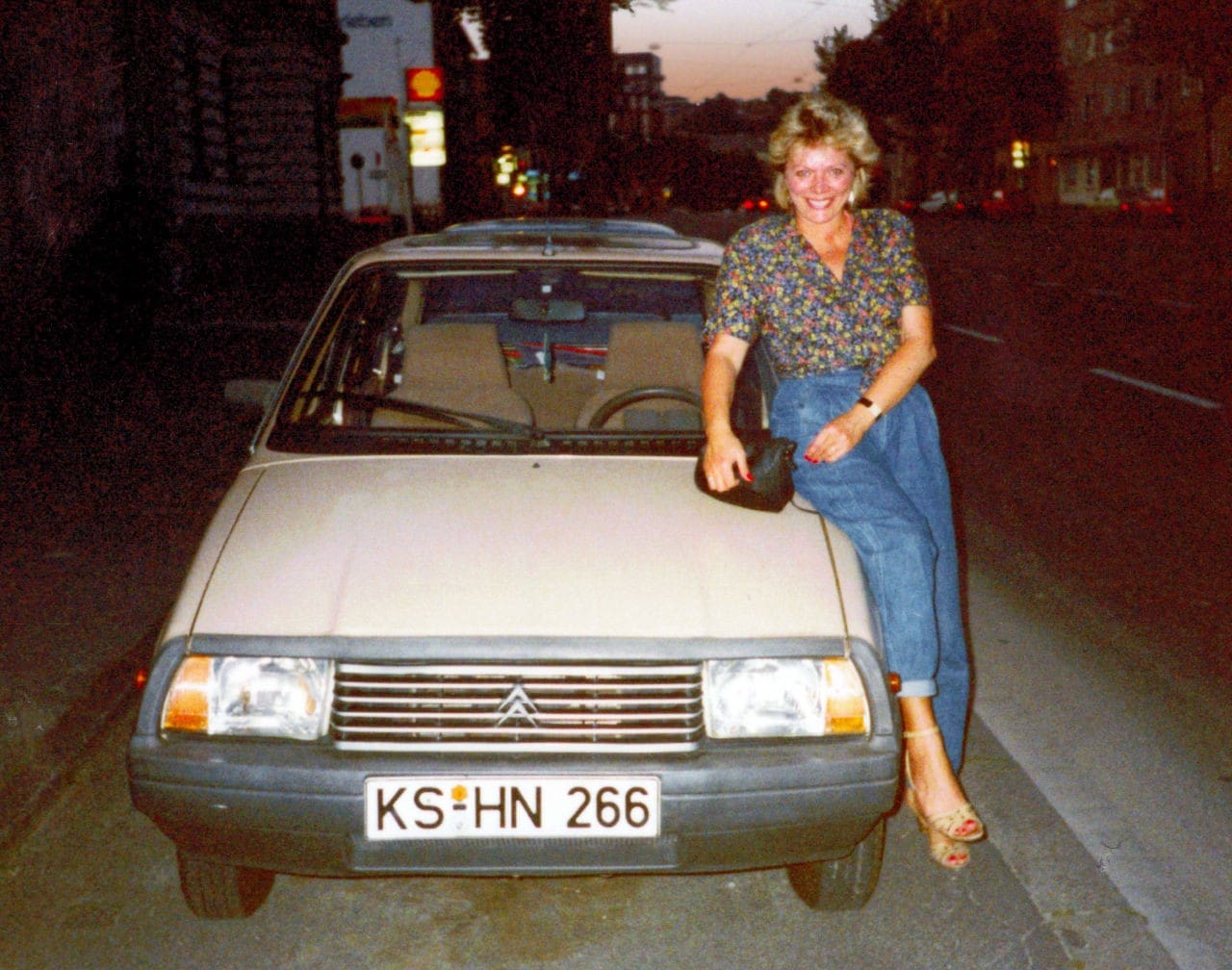
Technical data
| Citroën Visa II Super E (1983) | |
| Length | 369 cm |
| Width | 153 cm |
| Height | 140 cm |
| Turning circle | 9,6 m |
| Wheelbase | 242 cm |
| Boot min | 240 litres |
| Boot max | 520 litres |
| Unladen weight | 810 kg |
| Petrol | Regular petrol |
| Engine capacity | 1.124 cm³ |
| Power (PS) | 50 HP |
| at rpm | 5.500 rpm |
| Max. Torque (Nm) | 83 Nm |
| at rpm | 2.500 rpm |
| Gearbox | manual, 4 gears |
| Drive | Front |
| Top speed | 145 km/h |
| 0-100 (sec) | 20.6 sec |
| Fuel consumption | 7.3 litres/100 km |
| Price | from DM 10,990 (1981) |
| Converted purchase price 2021 | from 18,196 Euro (1981) |
| Year of construction from | 1978 – 1988 (1981 – 1988) |
Our circle of friends really enjoyed driving this thing when we travelled a bit further afield. It rolled really well and consumed nothing.
Mum also used to tow me away in the Visa. Once again, my Abarth had broken down on the motorway at night due to some kind of problem. The next day, a heavy rain had just fallen and we went to get the A112. My mother pulled me past many exits (yes, yes, it’s not allowed, you have to leave the motorway as quickly as possible!) all the way home. I was thrilled because the black Abarth was completely beige from the earth, sand and dirt that the Visa had swirled onto it. Rally style! It could stay like that!
Driving performance
The Citroen Visa ran like hell. At least when she was at the wheel. She could always pedal the thing to 170 on the motorway, but the car never wanted to do that with us.
Equipment
Single windscreen wiper, single-spoke steering wheel. The dashboard with the „Coke can“ was sensational. The silky and quiet engine running was remarkable (it was a four-cylinder, not a duck engine). Soft beige upholstery matched the beige paintwork. Actually very tasteful, but such a Visa was never a luxury vehicle. The colour scheme belied the almost primitive design of the dashboard. The brown dashboard with the sporty instruments looked pasted on. The entire dashboard was literally a board upholstered in artificial leather. There are pictures of it here.
Damage
Comfort and suitability for travelling outstanding, quality subterranean.
When she bought the car relatively new (IIRC it was two years old), the rear door sill on the driver’s side was already completely covered in rust on the outside. Imagine that today: You buy a two-year-old car and take it straight to a garage because it has rust?
Once, however, we stopped in the Kasseler Aue. The clutch cable had snapped and we could no longer disengage the clutch. What to do? Schröder got behind the wheel and said: „Oh, that’s no problem, you don’t need a clutch pedal!“. He said it and demonstrated it. The starter actually pulled the car away from the traffic lights, started the engine and, as we all know, you can change gear without the clutch if you have a bit of feeling. At the next set of traffic lights, simply turn the ignition key back to „off“ and the car stops. It’s all a question of timing.
BMW 320
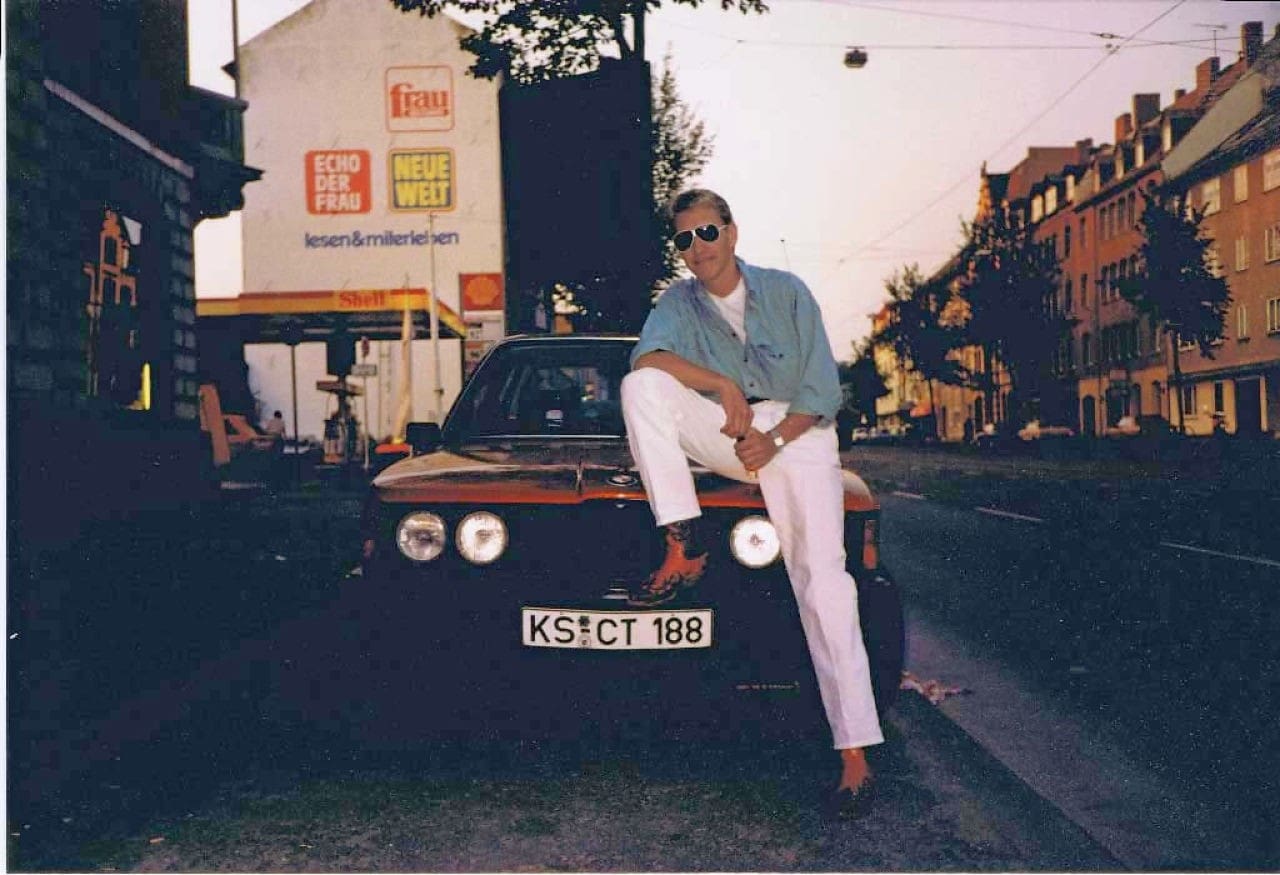
Technical data
| BMW 320/6 (1980?) | |
| Length | 436 cm |
| Width | 161 cm |
| Height | 138 cm |
| Turning circle | 9,6 m |
| Wheelbase | 256 cm |
| Boot min | 460 litres |
| Boot max | 460 litres |
| Unladen weight | 1.140 kg |
| Petrol | Premium petrol |
| Engine capacity | 1.990 cm³ (six-cylinder, twin carburettor) |
| Power (PS) | 122 HP |
| at rpm | 6.000 rpm |
| Max. Torque (Nm) | 163 Nm |
| at rpm | 4.000 rpm |
| Gearbox | manual, 4 gears |
| Drive | Rear |
| Top speed | 183 km/h |
| 0-100 (sec) | 10.7 sec |
| Fuel consumption | 9.4 litres/100 km |
| Price | from DM 19,850 (1979) |
| Converted purchase price 2021 | from 36,173 euros (1979) |
| Year of construction from | 1975 – 1983 (1977 – 1982) |
Driving performance
There is also Matzes BMW 320-6(E21) with which he often exceeded the speed limit (100 km/h) on the south tangent. Not to say: he put a big pile on it and more than doubled it.
Just as unimaginable today as the fuel consumption of this twin-carburettor environmental monster.
But the 3 Series always had a nice sound. As the motoring press of the time put it: „The BMW in-line six-cylinder engine successfully imitates the silky smooth running of a turbine.“
We also had memorable experiences with this car.
What was that like? We got stuck in the deep snow in front of the Löwenburg. I tried to push the BMW out of the snowdrift, swaying, when Schröder jumped out of the vehicle and helped push it along. First gear was still engaged and the six-wheeler simply spun the wheels at idle.
The three-wheeler got free, we cheered and looked after it as it roared merrily to freedom. Straight towards a tree. Matze rushed after it and jumped through the open side window. His lower body is still hanging outside. He manoeuvred around in the vehicle for what felt like an eternity without it stopping.
All I can remember is literally throwing my hands over my head and shouting, „Shoot!“, while in my mind’s eye I could already see his lower body being neatly severed from the tree.
Somehow he managed to take the bike out of gear and apply the brakes with his hand. I don’t know why he didn’t just turn the damn key.
The end
Unspectacular, because Schröder bought and sold his vehicles more often than the average German changes his pants. One day, something cooler came his way and the BMW was gone. It was as simple as that.
Opel Kadett C Coupé
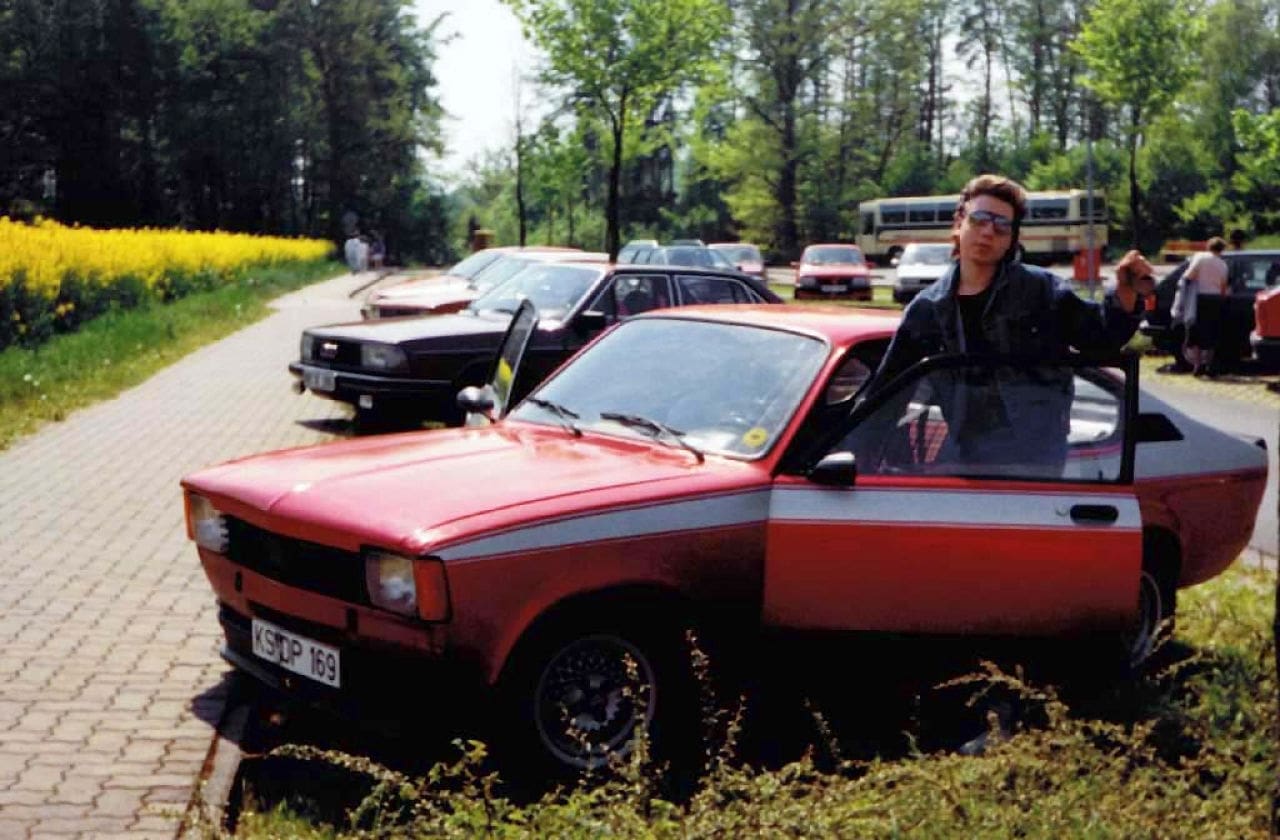
Technical data
| Opel Kadett C Coupé 1.6 S (1977?) | |
| Length | 413 cm |
| Width | 158 cm |
| Height | 134 cm |
| Turning circle | 9,8 m |
| Wheelbase | 238 cm |
| Boot min | 395 litres |
| Boot max | 395 litres |
| Unladen weight | 905 kg |
| Fuel consumption | Premium petrol |
| Engine capacity | 1.584 cm³ |
| Power (PS) | 70 HP |
| at rpm | 5.200 rpm |
| Max. Torque (Nm) | 113 Nm |
| at rpm | 3.800 rpm |
| Gearbox | manual, 4 gears |
| Drive | Rear |
| Top speed | 160 km/h |
| 0-100 (sec) | 13.0 sec |
| Fuel consumption | 9.2 litres/100 km |
| Price | from DM 10,380 (1976) |
| Converted purchase price 2021 | from 23,053 euros (1976) |
| Year of construction from | 1973 – 1979 (1977 – 1979) |
The Opel Kadett C Coupé went first from my cousin to Boris (in the picture) and then to Matze.
Another fond memory: I’m sitting in front of the stereo on a winter’s evening, listening to Iron Maiden. Loud, of course. Fourth floor, thick old building walls, double-glazed windows. Suddenly I hear a loud bang through the music. I take off my headphones and look out of the window. Hey, I know that car up there on the hill. Shortly afterwards, the doorbell rings and Boris and my brother come up. For my brother, this is what it looked like:
„Boris used to drive the Kadett up the slope by the garages as briskly as he liked. Every time I told him not to do that and what he was going to do if there was a woman with a pram up there around the corner.
One evening, nature taught him a lesson because he wouldn’t listen to me. As usual, he drove up at speed, hit the steering wheel with his embarrassing racing gloves to take the bend and nothing happened!
Unfortunately for us, the bend was icy. Once the bonnet and both mudguards were trapped under the massive railing of a rubbish bin barrier, which was not really impressed by the car. It’s a good thing that the two rubbish bins stopped our journey abruptly and that the car wasn’t 5 cm lower, otherwise our heads would probably have been severed.
The trolley played Newton’s Cradle with the containers in the headlights and they spun spectacularly on their own axis. Of course, I couldn’t resist the usual „I told you so“.“
Driving performance
The asthmatic 75 hp was completely overwhelmed by the rock-hard Koni yellow suspension and the 205 tyres. It regularly lost traffic light duels with my A112 Abarth and I drove in circles around it.
Hmmm, it could also have been due to the completely worn wishbones that I was driving in circles with the Abarth…
Boris then wanted to „tune“ the thing. He wanted me to screw a larger carburettor on it, which he had bought from somewhere. I don’t know what that would do for the 1.6, but I did him the favour. It’s really no big deal. A matter of 15 minutes or so. Opels are mechanic-friendly.
According to Boris, it did… absolutely nothing. Well, that was to be expected.
Damage
The Kadett impressively demonstrated what the word „Opel gold“ means. Both doors were completely through at the bottom and this automotive death trap split open at the A-pillar when it was on the lift.
Peugeot 305
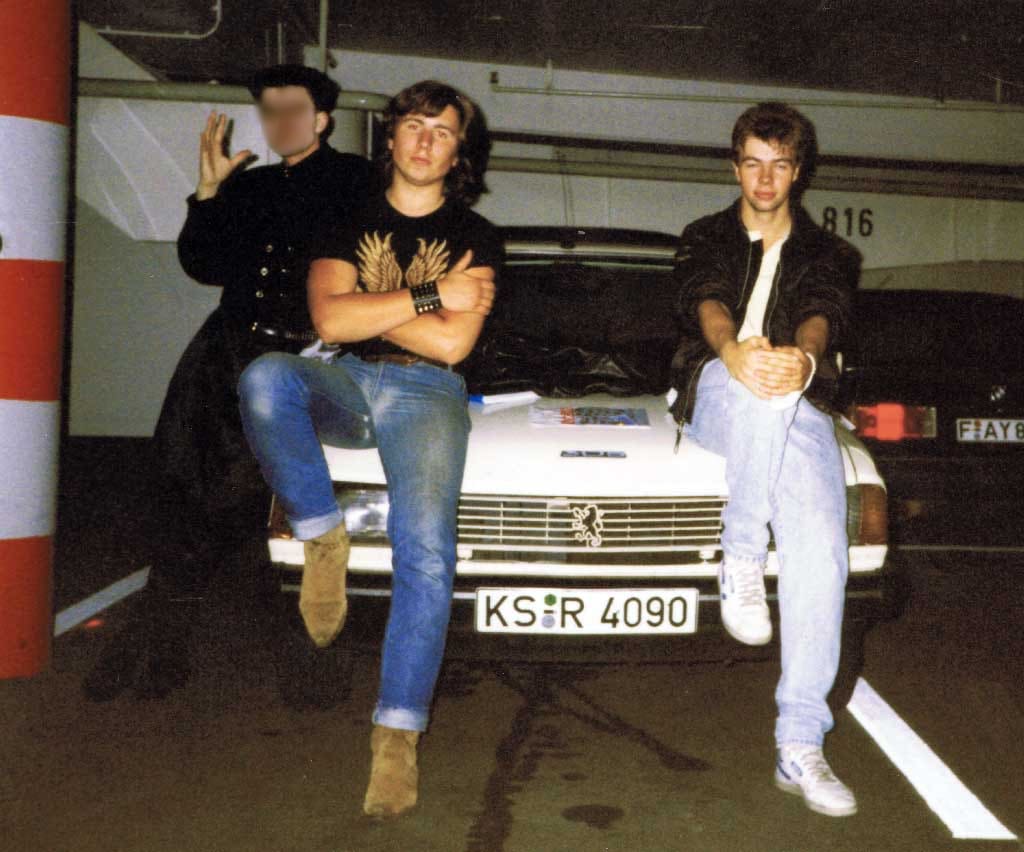
Technical data
| Peugeot 305 GR | |
| Length | 424 cm |
| Width | 163 cm |
| Height | 140 cm |
| Wheelbase | 262 cm |
| Turning circle | 11,1 m |
| Boot min | 464 litres |
| Boot max | 370 litres |
| Unladen weight | 950 kg |
| Fuel consumption | Regular petrol |
| Engine capacity | 1.472 cm³ |
| Power (PS) | 74 HP |
| at rpm | 6.000 rpm |
| Max. Torque (Nm) | 114 Nm |
| at rpm | 3.000 rpm |
| Gearbox | manual, 4 gears |
| Drive | Front |
| Top speed | 152 km/h |
| 0-100 (sec) | 13.2 sec |
| Fuel consumption | 6.2 litres Super |
| Price | from 16,490 DM (1983) |
| Converted purchase price 2021 | from 25,460 euros (2021) |
| Year of construction from | 1977 (from 1980 in Germany) |
Driving performance / damage
Harry’s Peugeot 305 (pictured to the right of Boris and my brother) was also asthmatic.
We once travelled from Kassel to Frankfurt in the Peugeot. It was comfortable. But… well… in the mountains of Kassel, this gem of French motoring could only manage a maximum of 60 km/h. Lorries overtook and honked their horns in protest. Harry remained incredibly calm, while we cramped up discreetly in the soft upholstery.
Back in Kassel, Harry asked me to have a look at what was going on. My God! Where do you start? Air filter on: clean. Spark plugs out, look at the combustion pattern… HA! Argh! My arse! The electrodes were almost gone! With new spark plugs, the car ran within normal parameters again, so it wasn’t so unreliable.
Alfa Romeo 2000 Berlina
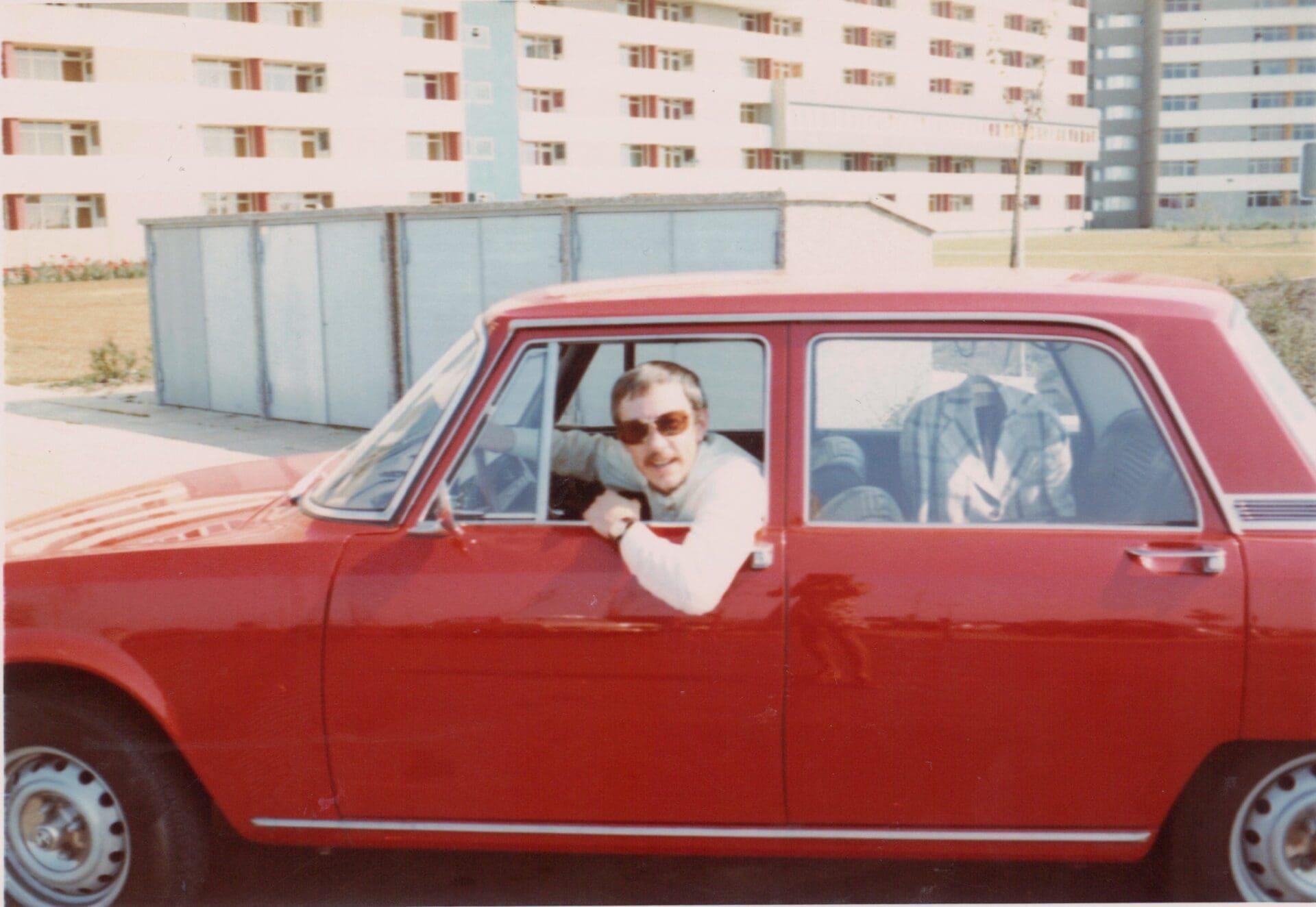
Technical data
| Alfa Romeo 2000 Berlina | |
| Length | 439 cm |
| Width | 157 cm |
| Height | 143 cm |
| Wheelbase | 257 cm |
| Turning circle | 11,5 m |
| Boot min | 480 litres |
| Boot max | 480 litres |
| Unladen weight | 1.110 kg |
| Petrol | Premium petrol |
| Engine capacity | 1.962 cm³ |
| Power (PS) | 131 HP |
| at rpm | 5.500 rpm |
| Max. Torque (Nm) | 207 Nm |
| at rpm | 3.500 rpm |
| Gearbox | manual, 5 gears |
| Drive | Rear |
| Top speed | 190 km/h |
| 0-100 (sec) | 9.5 sec |
| Fuel consumption | 12.1 litres Super |
| Price | from 14,890 DM (1969) |
| Converted purchase price 2021 | from 63,810 euros |
| Year of construction | 1969 |
My father used to drive Alfa Romeos in the 1960s and 1970s. Whether it was a Giulia with the Alfa crest on the bonnet or a 2,000 Berlina: they were all red. Real infernal machines. Please note the trendy, discreetly chequered jacket in the back of the Alfa. I guess caterers don’t like to be inconspicuous.
Fiat Nuova 500
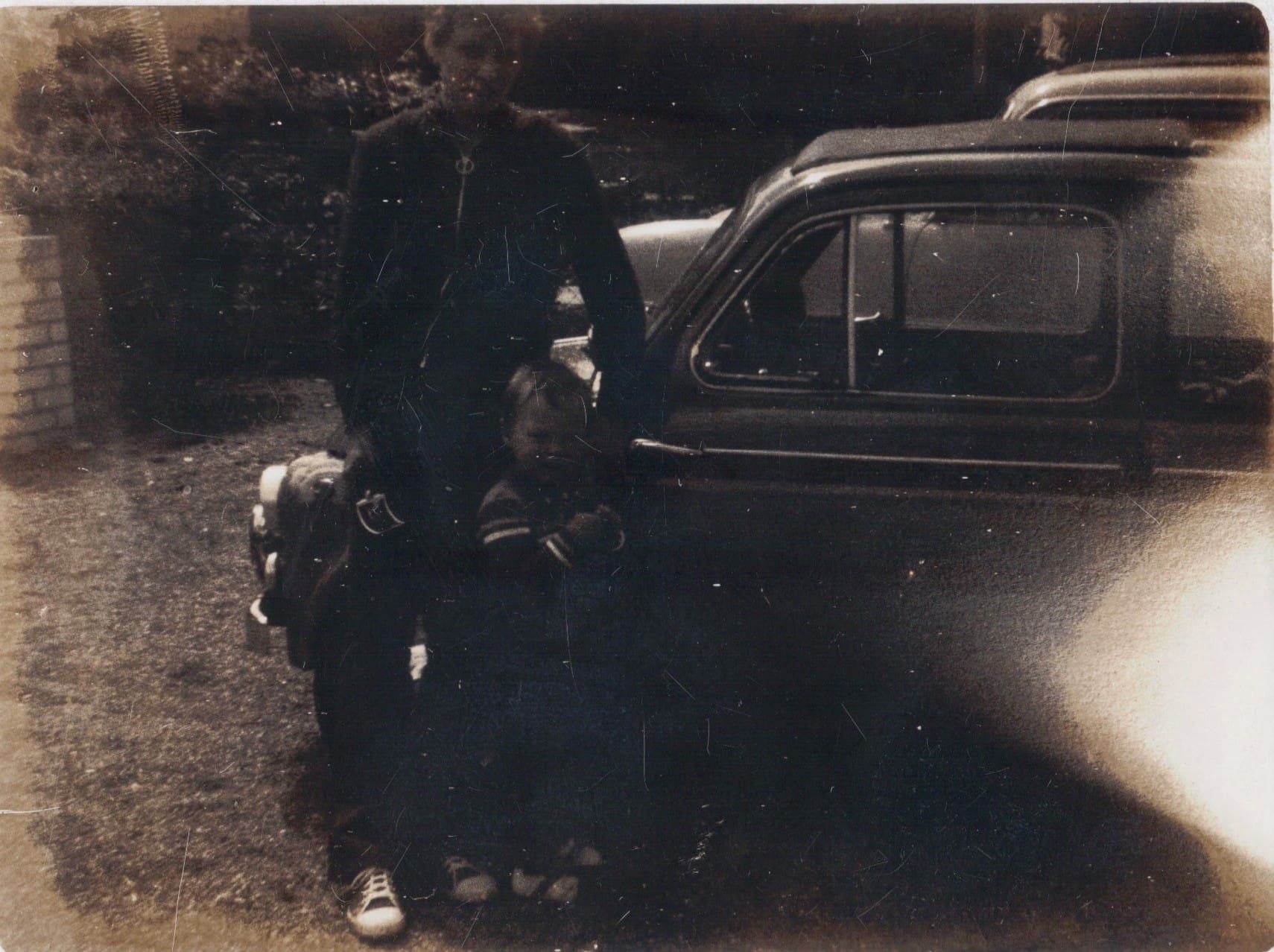
Technical data
| Fiat Nuova 500 D | |
| Length | 297 cm |
| Width | 132 cm |
| Height | 133 cm |
| Wheelbase | 184 cm |
| Turning circle | 8,6 m |
| Luggage compartment min | n.a. |
| Boot max | n.a. |
| Unladen weight | 500 kg |
| Fuel consumption | Regular petrol |
| Displacement | 499.5 cm³ two-cylinder |
| Power (PS) | 17.5 HP |
| at rpm | 4.400 rpm |
| Max. Torque (Nm) | 35.3 Nm |
| at rpm | 3.500 rpm |
| Gearbox | manual, 4 gears, unsynchronised |
| Drive | Rear |
| Top speed | 100 km/h |
| 0-100 (sec) | 90.0 sec (no joke!) |
| Fuel consumption | 4.8 litres/100 km |
| The price | from 3,350 DM (1965) |
| Converted purchase price 2021 | from 19,155 euros (1965) |
| Year of construction | 1957 – 1975 (1960 – 1965) |
Mum’s first „vehicle“ was a Fiat 500 in Porsche yellow. She drove it to the Baltic Sea with my grandmother and me. She still „raves“ about having to drive between the lorries. Fortunately, I no longer have any memories of travelling in this pothole detector.
Fiat 500 D vs Renault Twizy
Today I drive a vehicle with the same performance and similar weight with my Twizy. :-) Just for fun, let’s compare the Fiat 500 Nuova (1957) with the Renault Twizy (2012). Green = bigger or better. The unrated cells are the same, similar or not comparable.
| Fiat Nuova 500 D | Renault Twizy 80 | |
| Length | 297 cm | 234 cm |
| Width | 132 cm | 110 / 138 cm (cabin / chassis) |
| Height | 133 cm | 145 cm |
| Wheelbase | 184 cm | 168 cm |
| Turning circle | 8,6 m | 3,4 m |
| Seats | 4 | 2 |
| Boot | n.a., but available | not available (156 litres, cargo version with one seat) |
| Unladen weight | 500 kg | 562 kg |
| Fuel consumption | Regular petrol (fills up in 36 seconds) | 230 V, max. 2 kW charging power (charging in three hours) |
| Engine capacity | 499.5 cm³ Two-cylinder | Three-phase synchronous motor, three-phase |
| Power (PS) | 17.5 HP | 12 hp(18 hp for max. 30 minutes) |
| at rpm | 4.400 rpm | always |
| Max. Torque (Nm) | 35.3 Nm | 57 Nm |
| at rpm | 3.500 rpm | always |
| Gearbox | manual, 4 gears, unsynchronised | Reduction gearbox, 1 gear |
| Drive | Rear | Rear |
| Top speed | 100 km/h | 80 km/h (locked), 110 km/h (open, illegal) |
| 0-30 (sec) | approx. 4 sec | 3.6 sec |
| 0-50 (sec) | approx. 9 sec | 8.0 sec |
| 0-80 (sec) | approx. 22 sec | 15.0 sec |
| 0-100 (sec) | approx. 44.0 sec | not available |
| Fuel consumption | 4.8 litres/100 km | 6.3 kWh/100 km (2 Euro/100 km, approx. 1.5 litres/100 km, as of the end of 2021) |
| Price DM | from 3,350 DM (1965) | |
| Converted purchase price 2021 (price EUR) | from 19,155 euros (1965) | from 12,500 euros incl. battery (2021) |
| Year of construction | 1957 – 1975 (1960 – 1965) | 2012 – … |
The 500 is a compact car, the Twizy an L7E, a light electric vehicle.(All about the Renault Twizy. I also own the Renault Twizy as a 1:18 scale model))
Fiat 500 D: Suicide doors – Twizy: scissor doors – both are cool.
Scissor doors are ideal in tight car parks.
Neither vehicle has ABS or ESP. Both only have a single-circuit braking system. The Fiat has drum brakes all round, the Twizy has disc brakes all round.
The Fiat has heating and ventilation, the Twizy only has heating in the windscreen.
The rear wheels are 145 mm on the Twizy and 125 mm on both.
There is no need to say a word about safety, because the Twizy would simply drive through the Fiat 500. The Twizy has seat belts and an airbag.
Therange and „charging process“ are better/faster on the Fiat.
The Fiat 500 was more expensive, but has space for four people and a boot.
The Twizy is much cheaper to maintain (fuel consumption, taxes and insurance).
Cuteness factor: You are probably approached just as often in both vehicles.
Tempo small lorry (A 400 / Hanseat)
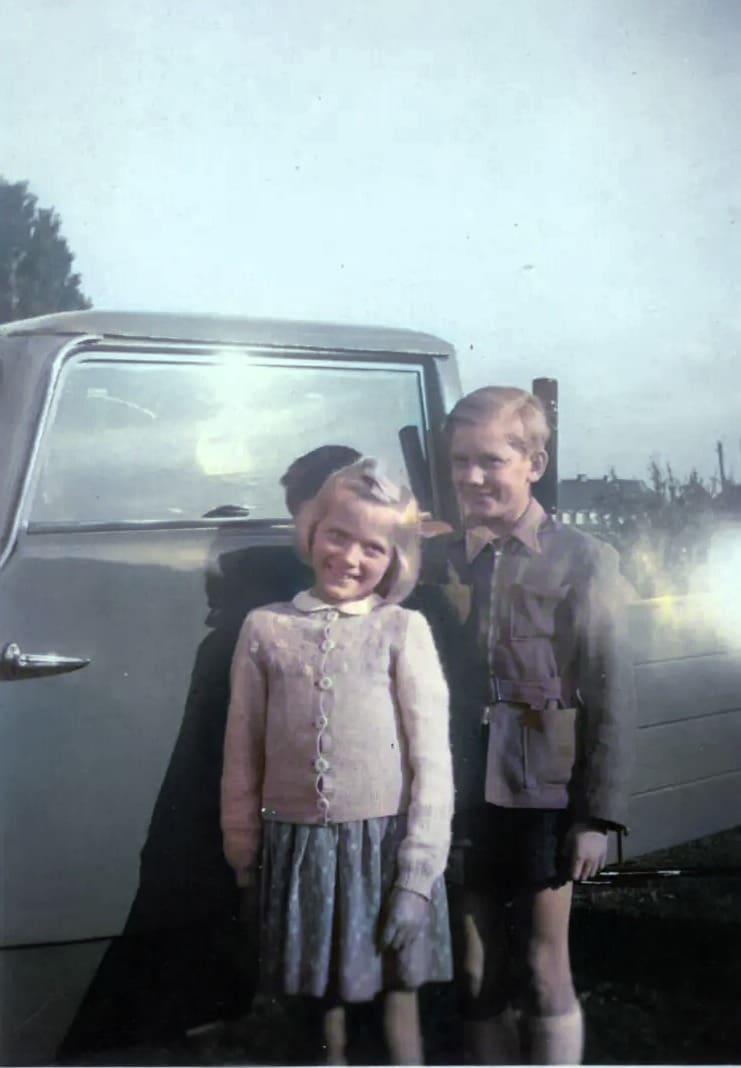
Technical data
| Tempo A 400 / Hanseat | |
| Length | 465 cm |
| Width | 173 cm |
| Height | 155 cm |
| Wheelbase | 287 – 357 cm |
| Turning circle | n.a. (should be very large) |
| Luggage compartment min | Dropside, 750 kg payload |
| Luggage compartment max | 250 × 160 cm loading area |
| Unladen weight | 720 kg |
| Fuel type | Normal petrol/oil mixture |
| Engine capacity | 397.4 cm³ Two-cylinder, two-stroke |
| Power (hp) | 12.5 HP |
| at rpm | 3.500 rpm |
| Max. Torque (Nm) | n.a. |
| at rpm | n/a |
| Gearbox | manual, 3 gears, unsynchronised |
| Drive | Front wheel (1) |
| Maximum speed | 50 km/h |
| 0-100 (sec) | not achievable |
| Fuel consumption | n.a. |
| Price | from 3,300 DM (1950) |
| Converted purchase price 2021 | from 54,000 euros (1950) |
| Year of construction | 1938 – 1950 |
In the old photo albums, I found a picture of my mother and her brother posing as children in 1951 in front of a three-wheeled Tempo small lorry that belonged to my grandmother’s boyfriend at the time. Compared to the children, this „lorry“ looks almost big. The photo was taken at the Fackelteich allotment garden association in Kassel.
„Family reunion“ 1972
Alfa Romeo 2000 Berlina
Opel Rekord
Simca 1000 Rally 2
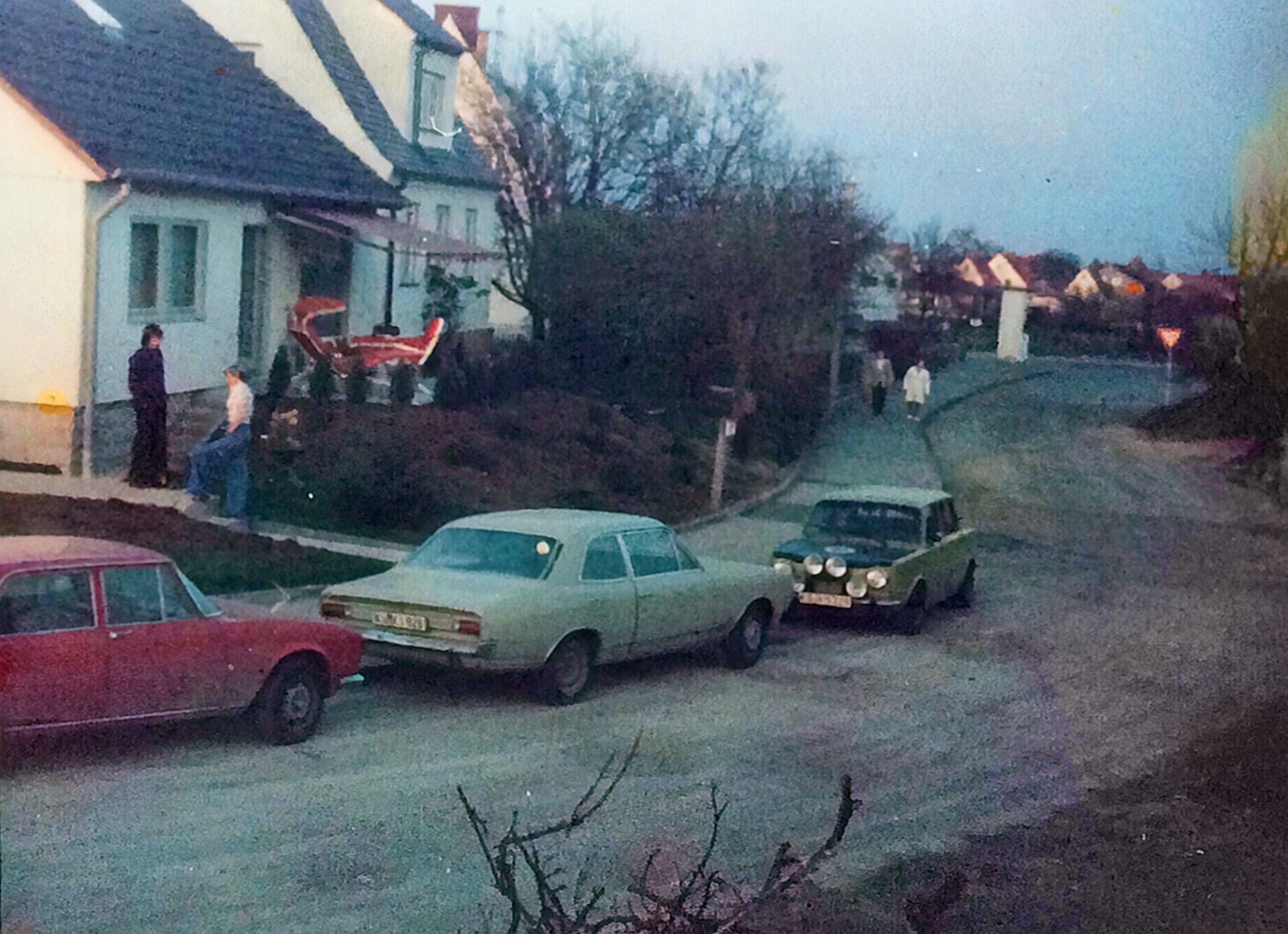
Technical data
| Alfa Romeo 2000 Berlina | Opel Rekord Coupé 1900 | Simca 1000 Rallye 2 | |
| Length | 439 cm | 455 cm | 381 cm |
| Width | 157 cm | 175 cm | 149 cm |
| Height | 143 cm | 145 cm | 139 cm |
| Wheelbase | 257 cm | 270 cm | 222 cm |
| Turning circle | 11,5 m | 11,9 m | 9,0 m |
| Boot min | 480 litres | 480 litres | 115 litres |
| Boot max | 480 litres | 480 litres | 115 litres |
| Unladen weight | 1.110 kg | 1.150 kg | 875 kg |
| Fuel consumption | Premium petrol | Regular petrol | Premium petrol |
| Engine capacity | 1.962 cm³ | 1.897 cm³ | 1.294 cm³ |
| Power (PS) | 131 HP | 90 HP | 82 HP |
| at rpm | 5.500 rpm | 5.100 rpm | 6.000 rpm |
| Max. Torque (Nm) | 207 Nm | 146 Nm | 108 Nm |
| at rpm | 3.500 rpm | 2.800 rpm | 4.400 rpm |
| Gearbox | manual, 5 gears | manual, 4 gears | manual, 4 gears |
| Drive | Rear | Rear | Rear |
| Top speed | 190 km/h | 158 km/h | 170 km/h |
| 0-100 (sec) | 9.5 sec | 18.0 sec | 11.8 sec |
| Fuel consumption | 12.1 litres Super | 12 litres/100 km | 9.8 litres/100 km |
| Price | from 14,890 DM (1969) | from 8,740 DM (1967) | from 7,495 (1972) |
| Converted purchase price 2021 | from 63,810 euros | from 42,635 euros | from 23,650 euros |
| Year of construction | 1969 | 1967 | 1972 |
Here my maternal uncle visited us in Fritzlar, Geismarrain 6.
He drove the brand-new, lime-green Simca 1000 Rallye 2, with which he became ADAC Hessen champion as a works driver the following year.
In front of it, my mother’s grey, two-door Opel Rekord 1900(?). Only half in the picture: my father’s red Alfa Romeo 2000 Berlina. The rally car is the cleanest vehicle here. Funny. But back then, the road was not yet paved and therefore dusty.
The picture was taken from a raised field. Today it’s all built up. Alfa, Opel and Simca – today expensive classics, back then just normal new cars
Opel Kadett B Coupe
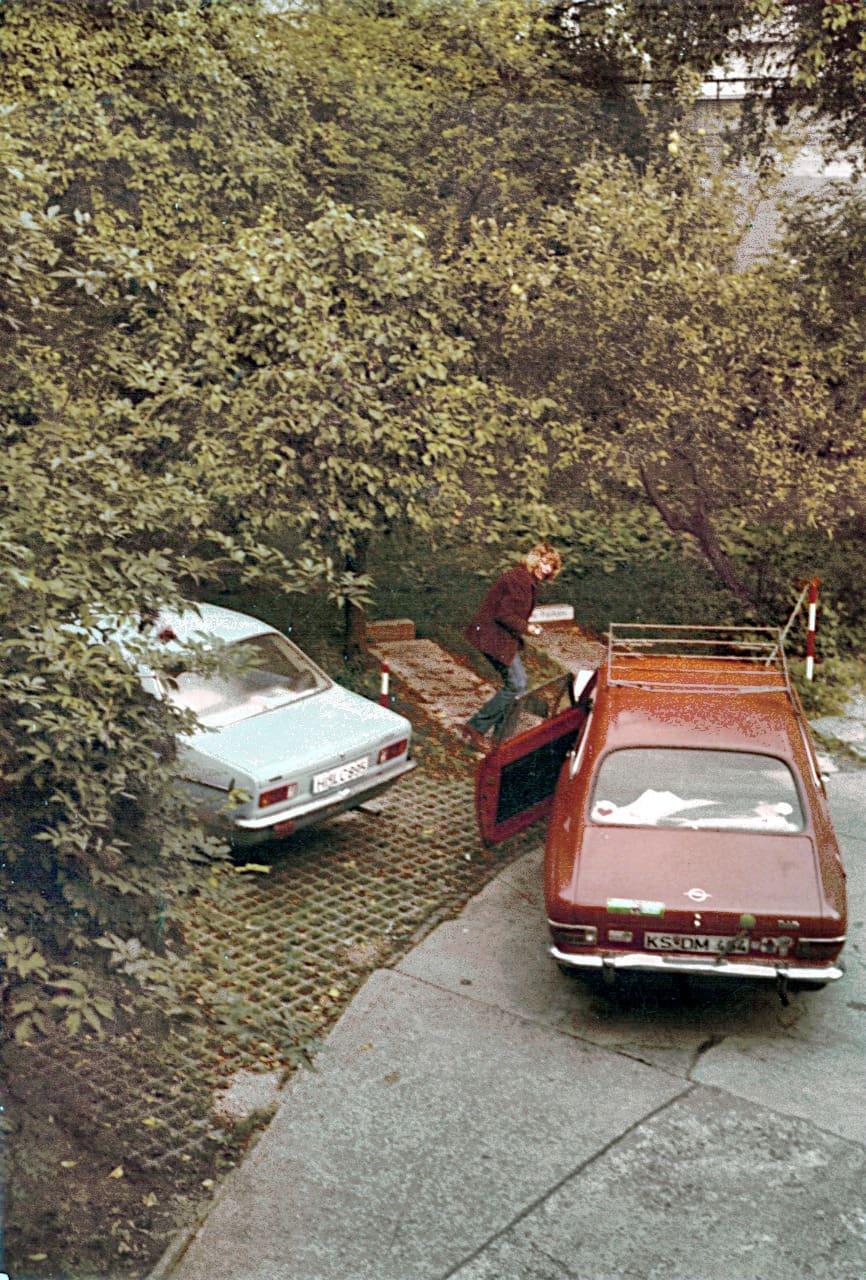
Cadets among themselves: B Coupe and C Limo
| Opel Kadett B Coupé | |
| Length | 415 cm |
| Width | 160 cm |
| Height | 140 cm |
| Wheelbase | 240 cm |
| Turning circle | 10,4 m |
| Boot min | 370 litres |
| Boot max | 370 litres |
| Unladen weight | 800 kg |
| Petrol | Premium petrol |
| Engine capacity | 1.078 cm³ |
| Power (PS) | 55 HP |
| at rpm | 5.400 rpm |
| Max. Torque (Nm) | 81 Nm |
| at rpm | 2.400 rpm |
| Gearbox | manual, 4 gears |
| Drive | Rear |
| Top speed | 135 km/h |
| 0-100 (sec) | 21,0 |
| Fuel consumption | 7,9 |
| Price | from DM 6,300 (1967) |
| Converted purchase price 2021 | from 30,100 euros |
| Year of construction | 1967 |
My mother’s B-Coupé is parked in a car park at our weekend house in Büchenwerra. Next to it (IIRC) is the sky-blue Kadett C saloon of the hot girlfriend of one of my mum’s work colleagues, who always supplied us with the latest VHS copies. Probably around 1977.
Yes, yes, I’ll never forget travelling to Italy in that coupe. There were no seat belts in the back anyway, but the fact that mum removed the back seat and we were sitting on the proverbial packed suitcases is something that today’s helicopter parent fraction can’t even begin to understand.
But we’re still alive. But we were also lucky, it has to be said, because with three times as much traffic today, road deaths fell to a tenth of that time.

